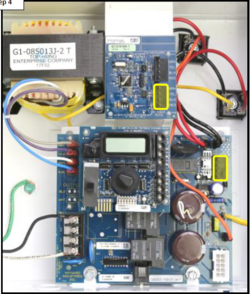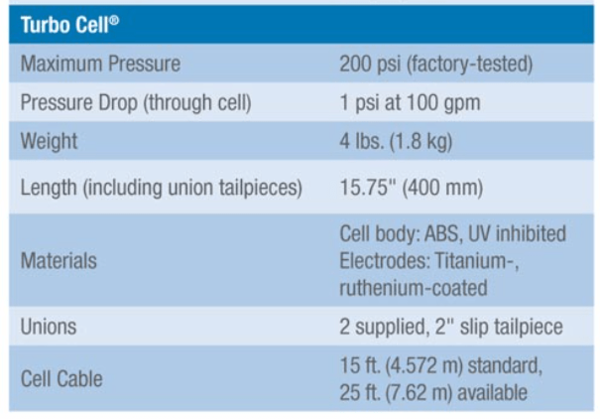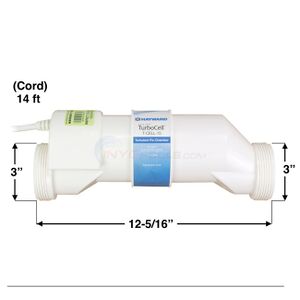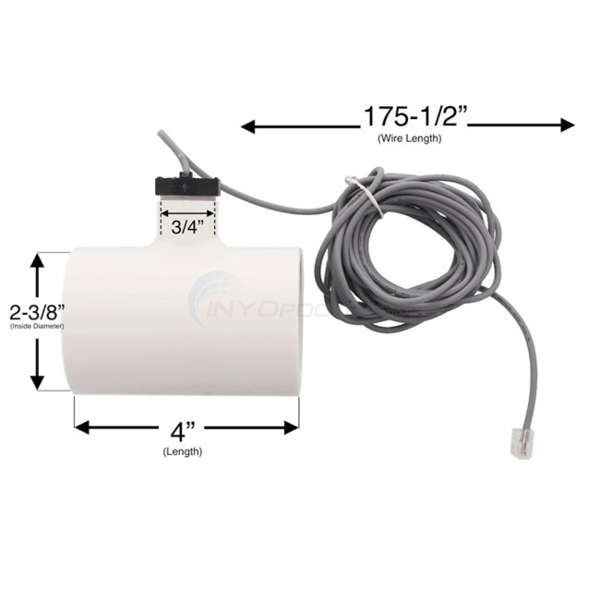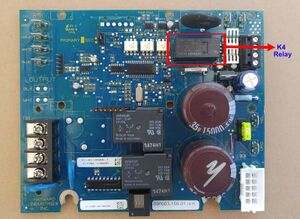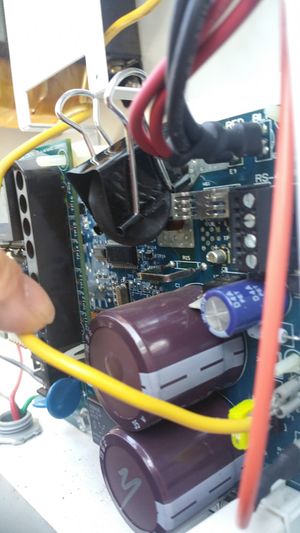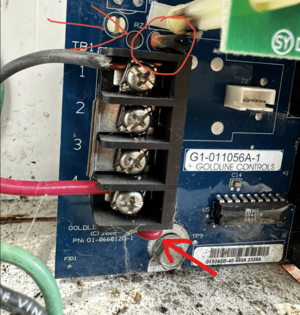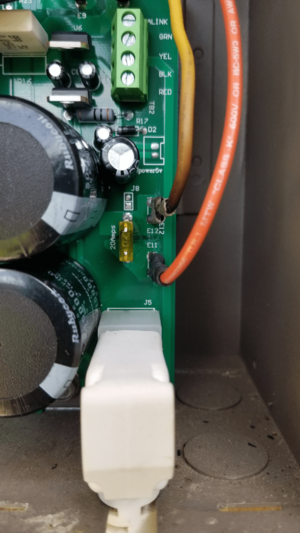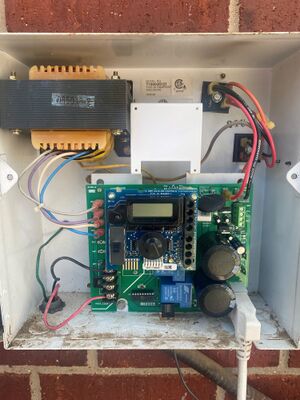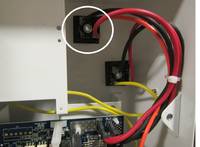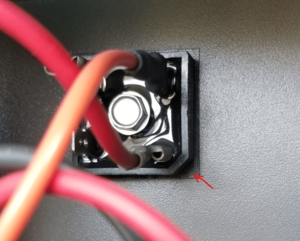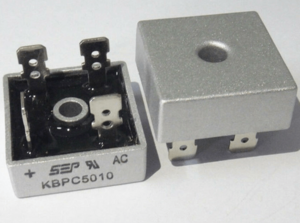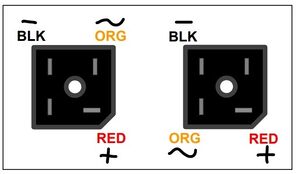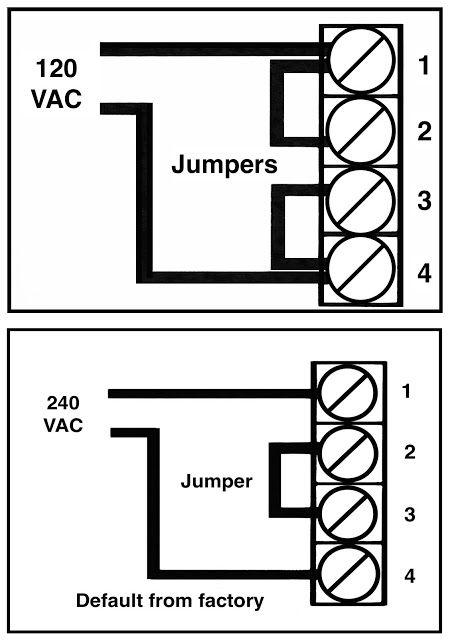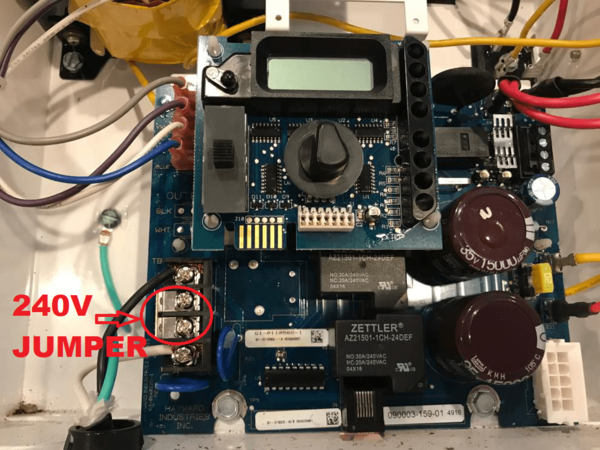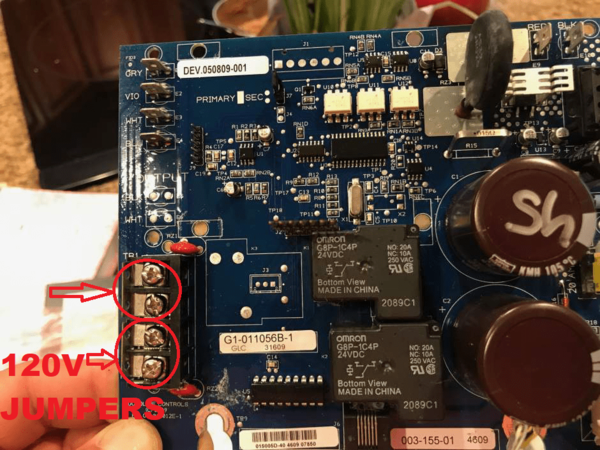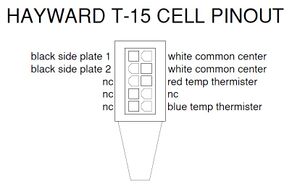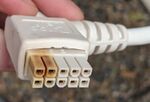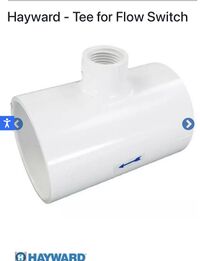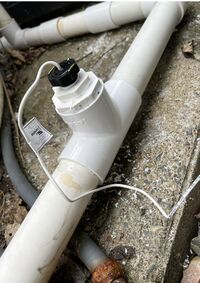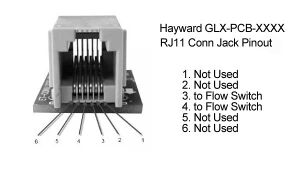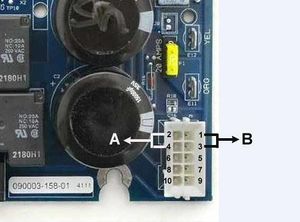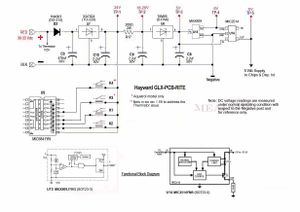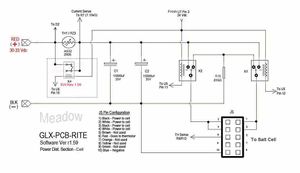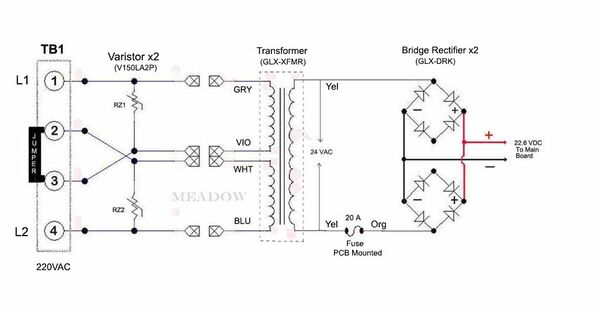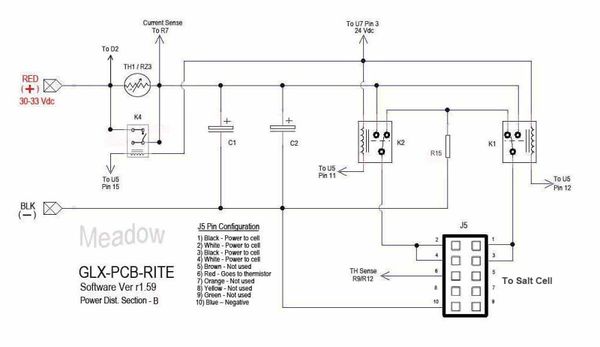| (92 intermediate revisions by 4 users not shown) | |||
| Line 1: | Line 1: | ||
| + | [[Category:Swimming Pool Equipment]] | ||
| + | |||
==Overview== | ==Overview== | ||
The Hayward Aquarite consists of two units: | The Hayward Aquarite consists of two units: | ||
| Line 9: | Line 11: | ||
*Mineral Springs MS-10 | *Mineral Springs MS-10 | ||
*Carvin Saniclear 20 | *Carvin Saniclear 20 | ||
| + | |||
| + | [https://www.totallyhayward.com/pdfs/authorized_online_sellers_table.pdf Hayward Authorized Online Sellers] shows which online sellers are authorized Hayward dealers. | ||
| + | |||
| + | ==Aquarite History== | ||
| + | |||
| + | Goldline Controls®, began as Independent Energy, Inc., a company founded in 1975. In 1994, the company began producing Aqua Rite® salt chlorinators for swimming pools. | ||
| + | |||
| + | Hayward® Industries, Inc. acquired Goldline Controls® in August 2004. | ||
==Basic AquaRite Diagnostics== | ==Basic AquaRite Diagnostics== | ||
| Line 14: | Line 24: | ||
This is the basic information we need to know in diagnosing a problem: | This is the basic information we need to know in diagnosing a problem: | ||
| − | *Report all readings when you.. | + | *Report all diagnostic readings when you.. |
**Move the switch from auto to off and check all of the readings. | **Move the switch from auto to off and check all of the readings. | ||
**Move the switch back to auto and recheck the readings. | **Move the switch back to auto and recheck the readings. | ||
| Line 21: | Line 31: | ||
*What is the actual salinity and how are you measuring it? | *What is the actual salinity and how are you measuring it? | ||
| − | == | + | ==VS Omni Connection== |
| − | + | [[File:Hayward AQR Daughter Board.png|250px|thumb]] | |
| − | + | A AQR Communication Board aka a daughter board needs to be installed in the Aquarite to communicate with VS Omni automation through a RS-485 data link. | |
| − | + | The [https://www.troublefreepool.com/attachments/aqr-daughter-board-htg_aqrdba-pdf.139863/ AQR Daughter Board Installation Manual] is attached to [https://www.troublefreepool.com/threads/new-install-of-omni-hub-aquarite-integration.204579/post-1804964 this thread.] | |
| − | |||
| − | |||
| − | |||
| − | |||
| − | |||
| − | |||
| − | + | ===How to Reset Omni’s Salt Average when using an AquaRite Chlorinator=== | |
| − | + | When using an AquaRite ( with daughterboard ) connected to an Omni control use the steps | |
| + | below to reset the salt average.<ref>https://www.totallyhayward.com/techservices/attachments/Technical%20Updates%20for%20Pool%20Professionals%20%20October%202020.pdf</ref> | ||
| + | *The AquaRite’s salt average cannot be reset from the Omni display or App | ||
| + | *Resetting the salt average requires being at the AquaRite panel | ||
| + | *The salt average on the Omni control’s chlorinator diagnostic screen may take up to 30 seconds to update | ||
| − | + | #To reset, move the switch to ‘Off’ and then back to ‘Auto’. Wait for the relay to click (5 to 10 seconds). | |
| + | #Press Diagnostics button 5 times to display the Instant Salt level. Wait for the number to stabilize. | ||
| + | #When the instant salt level is stable (and the negative sign still present), slide switch to ‘Super Chlorinate’ and back to ‘Auto’. | ||
| + | #It takes about 30 seconds for the unit to settle back on the default reading. It should now reflect the new average salt level. | ||
| − | + | NOTE: Repeat this process once more to ensure both polarities are reading within 500ppm of | |
| + | each other. | ||
| − | + | ==Aquarite T-Cells== | |
| + | ===Cell chlorine Generating Capacity=== | ||
| + | Each cell T-3, T-5, T-9, T-15 will produce a specific quantity of chlorine before it is depleted.<ref>https://www.troublefreepool.com/threads/aquarite-dead-generic-cells-for-hayward-aquarite.113196/post-1002846</ref><ref>https://hayward-pool-assets.com/assets/documents/pools/pdf/literature/salt-chlorination-LITSLTB15.pdf?fromCDN=true</ref> | ||
| − | T-Cell-15 ( | + | {| class="wikitable" |
| + | |+ Hayward SWCG Cell Specifications | ||
| + | |- | ||
| + | ! CELL !! GALLONS !! LBS/DAY !! LIFETIME CL LBS(1) !! LIFETIME | ||
| + | |- | ||
| + | | T-Cell-3 || 15,000 || 0.53 || 210 || | ||
| + | |- | ||
| + | | T-3 || 15,000 || 0.53 || 193 ||364 days at 100% or 8,736 hours at 100% | ||
| + | |- | ||
| + | | T-Cell-5 || 20,000|| 0.636 to 0.784 || || | ||
| + | |- | ||
| + | | T-5 || 20,000|| 0.636 to 0.784 || || | ||
| + | |- | ||
| + | | T-Cell-9 (925) Extended Life || 25,000 || 0.98 || 480 || | ||
| + | |- | ||
| + | | T-9 || 25,000 || 0.98 || 354 || 361 days at 100% or 8,664 hours at 100% | ||
| + | |- | ||
| + | | T-15 || 40,000 || 1.47 || 580 || 362 days at 100% or 8,688 hours at 100% | ||
| + | |- | ||
| + | | T-Cell-15 (940) Extended life || 40,000 || 1.47 || 725|| | ||
| + | |} | ||
| − | + | (1)Equivalent pounds of Trichlor produced over the lifetime of the cell with properly maintained cell and water chemistry. | |
===Which T Cell Should I Buy?=== | ===Which T Cell Should I Buy?=== | ||
| Line 53: | Line 87: | ||
===T-15 Cell Types=== | ===T-15 Cell Types=== | ||
| − | The Hayward T-Cell-15 and Hayward T-Cell-15-SWP are the same thing. | + | The Hayward T-Cell-15 and Hayward T-Cell-15-SWP are the same thing. The T-15 has 13 Titanium Plates, 150 x 63mm. |
The T-Cell-15 has a 3 year warranty. | The T-Cell-15 has a 3 year warranty. | ||
| Line 64: | Line 98: | ||
A T-15-W is a warranty replacement cell with a 1 year warranty. It's not designated as a retail cell. It's supposed to be used as a replacement for a cell that fails under warranty. Some places sell warranty cells as regular cells. | A T-15-W is a warranty replacement cell with a 1 year warranty. It's not designated as a retail cell. It's supposed to be used as a replacement for a cell that fails under warranty. Some places sell warranty cells as regular cells. | ||
| + | |||
| + | ===T Cell Authentication Error=== | ||
| + | |||
| + | It seems Hayward has implemented authentication for genuine cells with their latest cell models. | ||
| + | |||
| + | We think that the new software uses 2 wires to "Authenticate" the cell to try to prevent generic aftermarket cells from being used. Likely the yellow and orange wires in the T cell connector (pins 7 & 8) are the authentication wires. | ||
| + | |||
| + | If your Hayward system is rejecting a Hayward genuine cell you need to call Hayward Support for assistance. Right now we do not know a way around the authentication. | ||
| + | |||
| + | ===T Cell Specifications=== | ||
| + | |||
| + | [[File:Hayward T Cell Dimensions.png|600px|frameless]] | ||
| + | |||
| + | [[File:Hayward Aquarite Tcell15 Dimensions.jpg|thumb]] | ||
| + | |||
| + | [[File:Hayward Flow Switch Dimensions.png|600px|frameless|Flow Switch Dimensions]] | ||
===Generic T-15 Cell Replacements=== | ===Generic T-15 Cell Replacements=== | ||
| Line 89: | Line 139: | ||
To determine the total output (lbs chlorine gas) per day check the amps while running and multiply by 0.18.<ref>https://www.troublefreepool.com/threads/ph-and-acid-base-demand.203597/post-1794221</ref> | To determine the total output (lbs chlorine gas) per day check the amps while running and multiply by 0.18.<ref>https://www.troublefreepool.com/threads/ph-and-acid-base-demand.203597/post-1794221</ref> | ||
| + | |||
| + | You can run a regular Aquarite with a T-15 cell and set the cell size to T-9 or T-5 to run at lower salinity. With the T-15 cell you can run the salinity at about 1,600 with the cell type to T-5. You can run at about 2,400 with the cell type set to T-9. | ||
| + | |||
| + | ===Aquarite S3 Omni Low Salt=== | ||
| + | |||
| + | The Aquarite S3 has a Low Salt mode that can be selected. | ||
| + | |||
| + | The AQR S3 Omni can generate chlorine using a range of salt concentrations from between 2700 – 3400 PPM (Standard Salt mode) or 1200-1800 PPM (Low Salt mode).<ref> https://www.troublefreepool.com/threads/how-much-salt-in-pool-for-new-turbocells-s3.267312/post-2340564 </ref> | ||
| + | |||
| + | The operating salt level is between 2700 – 3400 PPM when in Standard Salt mode or 1200-1800 PPM when in Low Salt mode (see page 30). | ||
| + | |||
| + | You select Salt Monitoring Level and select Standard Salt or Low Salt. | ||
| + | |||
| + | If running the system using a low salt level (1200 PPM-1800 PPM, 1500 PPM optimal) select Low Salt. | ||
| + | |||
| + | If running the system using standard salt level (2700 PPM - 3400 PPM, 3200 PPM optimal), select Standard Salt. | ||
| + | |||
| + | Basically with half the salt the cell will generate at half of its rated capacity. | ||
| + | |||
| + | *TCELLS340 generates up to 1.45 lbs. of chlorine per day at high salt or up to 0.725 lbs at low salt levels. | ||
| + | *TCELLS325 generates up to 0.98 lbs. of chlorine per day at high salt or up to 0.49 lbs at low salt levels. | ||
| + | *TCELLS315 generates up to 0.53 lbs. of chlorine per day at high salt or up to 0.265 lbs at low salt levels. | ||
| + | |||
| + | ===Aquarite Cell Plates=== | ||
| + | |||
| + | Here are the dimensions of the Hayward plates:<ref>https://www.troublefreepool.com/threads/aquapure-1400-121-error.218408/post-1927819</ref> | ||
| + | |||
| + | T-15 has 13 Titanium Plates, 150 x 63mm. Produces 1.47 lbs/day. | ||
| + | |||
| + | T-9 has 13 Titanium Plates, 101 x 63mm. Produces 0.98 lbs/day. | ||
| + | |||
| + | T-5 has 7 Titanium plate, 150 x 63mm. Produces 0.735 lbs/day. | ||
| + | |||
| + | T-3 has 7 Titanium Plates, 101 x 63mm. Produces 0.53 lbs/day. | ||
==Determining Salinity== | ==Determining Salinity== | ||
| Line 106: | Line 190: | ||
If there was a separate salinity sensor in the cell, the salinity would not change when the tcell type was changed.<ref>https://www.troublefreepool.com/threads/how-salt-systems-determine-salinity.114565/</ref> | If there was a separate salinity sensor in the cell, the salinity would not change when the tcell type was changed.<ref>https://www.troublefreepool.com/threads/how-salt-systems-determine-salinity.114565/</ref> | ||
| + | |||
| + | ===Hayward Support Response=== | ||
| + | |||
| + | Hayward Support responded the following to a member who questioned differences in salt readings displayed on the Omnilogic display vs. the Taylor K-1766 test kit:<ref>https://www.troublefreepool.com/threads/hayward-swg-instant-salt-vs-average-salt-vs-drop-test-results.248083/post-2177742</ref> | ||
| + | |||
| + | The cell has 2 polarities. It reverses polarity based on the output percentage. The calibration procedure manually does this. When the polarity is reversed, the average salt resets. We don't assume either reading is correct. That's why you need to have it independently verified. Yes, we allow a variance of 500 ppm with our salt chlorinators. | ||
| + | |||
| + | The salt level is calculated by an algorithm in the main board that uses the voltage, amperage and water temperature. The unit may need to be calibrated. Go to the main MSP panel. Press on the chlorinator icon. Press on the magnifying glass icon. Press the +/- icon to calibrate the salt level. | ||
| + | |||
| + | The salt cell you have is an extended life cell. To make these cells extended life the cell plates are over coated with ruthenium, and this will make it read a higher salt level then you have in the pool. As the rethenium wears off the plates the salt levels will come down closer to what you have in the pool. | ||
| + | |||
| + | When using a variable speed pump it is recommended that the cell be plumbed in vertical position. By doing this the cell will fill even when the pump is running in a lower speed. If the cell is plumbed horizontally, and the pump is running in low speed, the cell will not fill completely with water, and cause it to read a false low reading. | ||
| + | |||
| + | Drain a few units from the pool and replenish with fresh water. The coating material is not visibly evident like debris would be. You want to have enough flow to completely cover the internal cell plates. Attempting to operate the unit on a low RPM setting will cause the plates not to be submerged and will give you erratic salt readings. | ||
| + | |||
| + | 2800 ppm - that should cover all the cell plates if there's not a blockage to the water flow (like a clogged filter). | ||
| + | |||
| + | The variance is more than 500 ppm. Is the cell new? Some cells leave the factory with an extra coating on the internal cell plates. This causes it to read higher upon installation (usually around 1000 ppm higher). You can remove a few inches of water and replenish with fresh to "trick" the system. As the extra coat wears away, you should start to see the levels normalize. The extra coating will actually extend the life of the cell. | ||
==Cell Diagnostics== | ==Cell Diagnostics== | ||
| Line 119: | Line 221: | ||
*Cell type | *Cell type | ||
| − | The [http:// | + | The [http://www.haywardnet.com/pdfs/AquaRite-Troubleshooting-Guide.pdf?fromCDN=true Hayward Aquarite Troubleshooting Guidelines] explains each reading. |
| + | |||
| + | *Instant salt = the cells reading of the current salt PPM | ||
| + | *Average Salt = the average salt reading of the last 3 cycles of the cell. | ||
| − | To estimate the performance of the Aquarite cell, divide the instant salinity reading by the actual salinity. If the performance is less than 75%, the cell is failing and it's time to | + | To estimate the performance of the Aquarite cell, divide the instant salinity reading by the actual salinity. If the performance is less than 75%, the cell is failing and it's time to consider replacing the cell. You need to be sure about the actual salinity by using a salt test like the [[Salt#Taylor_K-1766_Salt_Test|Taylor K-1766]]. |
Check the instant salinity reading and then cycle power to reverse polarity and recheck the instant salinity reading. The numbers should be about the same +/- 200 ppm. | Check the instant salinity reading and then cycle power to reverse polarity and recheck the instant salinity reading. The numbers should be about the same +/- 200 ppm. | ||
You can get the age of the cell from the serial number. It will be 3Exx, where xx is the year it was made. | You can get the age of the cell from the serial number. It will be 3Exx, where xx is the year it was made. | ||
| + | |||
| + | ===Change Temperature and Salt Display to English or Metric Units=== | ||
| + | |||
| + | The salt and temperature display can be in English units of ppm and F or changed to Metric units of g/l and C by the following: | ||
| + | |||
| + | #Slide the Main Switch to the "Auto" position. | ||
| + | #Push the Diagnostic button repeatedly until "ºF" appears on the display. | ||
| + | #Slide the Main Switch from "Auto" to "Super Chlorinate" and back to "Auto". | ||
| + | #Push the Diagnostic button to exit. | ||
===Change Cell Type=== | ===Change Cell Type=== | ||
With the correct cell in place, move the switch to auto and momentarily push the diagnostic button to display the cell type "T-X". Then move the switch to Superchlorinate and back to auto 3x or until T-15 or whatever the correct cell type is shown on the display. | With the correct cell in place, move the switch to auto and momentarily push the diagnostic button to display the cell type "T-X". Then move the switch to Superchlorinate and back to auto 3x or until T-15 or whatever the correct cell type is shown on the display. | ||
| + | |||
| + | ====Prior to Revision 1.50==== | ||
| + | Revision 1.50 added the ability to select the T-cell type in the settings. Prior to revision 1.50, the system was preset to take a T-5 or T-15. | ||
| + | |||
| + | The earlier boards have a jumper on the board to select the cell type of T5 or T15. In some cases the jumper is adjustable and in some cases it requires that you solder the points together to select the T15 option if the board originally came set to T-5. | ||
| + | |||
| + | As long as the generic is a T5 or T15, and the jumper is set correctly, the cell will work. | ||
===Change Product Name=== | ===Change Product Name=== | ||
| Line 135: | Line 256: | ||
Move the switch to auto and momentarily push the diagnostic button to display the Product Name "AL-X".<ref>https://www.troublefreepool.com/threads/aquarite-t15-failing.212388/post-1860565</ref> Then move the switch to Superchlorinate and back to auto 3x or until the desired AL-X is shown on the display. | Move the switch to auto and momentarily push the diagnostic button to display the Product Name "AL-X".<ref>https://www.troublefreepool.com/threads/aquarite-t15-failing.212388/post-1860565</ref> Then move the switch to Superchlorinate and back to auto 3x or until the desired AL-X is shown on the display. | ||
| − | *AL-0 is AquaRite | + | For regular AquaRite, the setting can be changed from AL-0 to Al-5. |
| − | *AL-1 NatureSoft | + | |
| − | *AL-2 MineralSprings | + | For Aquatrol, the AL setting is either set to AL-6 or AL-7. |
| − | *AL-3 SmartPure | + | |
| + | The regular Aquatrol uses a flow switch. The RJ (Return Jet) model doesn't use a flow switch. | ||
| + | |||
| + | The model number should be inside the door. | ||
| + | |||
| + | In diagnostics, AL-6 means regular Aquatrol, AL-7 means return jet. | ||
| + | |||
| + | I'm sure that there's a way to change the setting, but Hayward isn't releasing that information. | ||
| + | It is the name sent to an automation system. | ||
| + | |||
| + | *AL-0 is AquaRite. | ||
| + | *AL-1 NatureSoft. | ||
| + | *AL-2 MineralSprings. | ||
| + | *AL-3 SmartPure. | ||
*AL-4 This changes the default display from average salt to percent output. | *AL-4 This changes the default display from average salt to percent output. | ||
*AL-5 This is used with Jandy automation. | *AL-5 This is used with Jandy automation. | ||
| + | *AL-6 means regular Aquatrol with a flow switch. | ||
| + | *AL-7 means AquaTrol RJ (Return Jet with no flow switch). | ||
| + | AL-6 and AL-7 are used on the AquaTrol, which is an AquaRite with a timer for above ground pools. | ||
| + | |||
| + | AquaRite, Naturesoft, Mineral Springs and Smartpure are essentially the same unit with different branding. Hayward does private labels for certain companies. Al-0 to al-3 are basically equivalent other than a superficial name change. AL-4 is not about the name, it just changes the default display. AL-5 needs to be selected for the Jandy automation to control the unit properly. | ||
| + | |||
| + | Sometimes an AquaRite will get stuck on AL-6 or AL-7 with no way to switch back and sometimes an Aquatrol will get switched to AL-0 through AL-5 with no (known) way to switch back. | ||
| + | |||
| + | ==INSPECT CELL Light== | ||
| + | |||
| + | Aqua Rite salt chlorinator has a built in reminder to inspect and clean the cell every 500 hrs.<ref>https://blog.hayward-pool.com/maintenance/how-to-reset-inspect-cell-light/</ref> | ||
| + | |||
| + | If the Inspect Cell Light is the only LED light flashing, then you can reset it by simply holding down the diagnostic button for 3 seconds, then release. The Inspect Cell indicator will now reset and will later come back on after another 500 hours of use. | ||
| + | |||
| + | ==CHECK SALT Light== | ||
| + | |||
| + | First, check the display salt reading – if it’s 2,700 ppm or lower, the check salt light will come on. You should not trust the calculated salinity displayed and do an independent salinity test with a [https://tftestkits.net/TF-Salt-Bundle-p132.html TF Salt Test] or [https://tftestkits.net/Taylor-K-1766-Salt-Test-Kit-p31.html Taylor K-1766 Salt Test]. | ||
| + | |||
| + | If the salt level is fine, inspect the Cell and clean if necessary. Never add salt without first having the water tested independent of the Aqua Rite reading. Salt only leaves the pool from backwashing a filter, splash out, leak or draining water from the pool. | ||
==COLD Water Temperature== | ==COLD Water Temperature== | ||
| Line 146: | Line 299: | ||
*The cell shuts off when water temperature at 50F and below | *The cell shuts off when water temperature at 50F and below | ||
*LCD displays COLD when water temperature is below 50F | *LCD displays COLD when water temperature is below 50F | ||
| + | |||
| + | For the Aquarite, if the display shows either "HOT or COLD" and you know it is false, then most likely the non-repairable temperature sensor inside the cell went bad. | ||
| + | |||
| + | Disconnect the cell, measure the resistance of the temperature sensor (pin 6 against pin 10 on the plug). Or access the wiring connection inside the cell, nip either the red or blue wire and test. Turn on the swcg, push the diagnostic button once to get rid of the possible "COLD" error. Run the diagnostic, the temperature should read 77°F regardless of the actual water temp. | ||
| + | |||
| + | If the cell is still good, you can temporarily install a 10kΩ, 1/4 watt resistor across the red and blue wire inside the cell or rig your own temp sensor. | ||
| + | |||
| + | A hack to bypass the cell temperature sensor can be found at [https://www.troublefreepool.com/threads/t-15-cell-hot-error-salt-reading-low-solved-dead-thermistor.232775/#post-2038769 T-15 Cell "Hot" Error, Salt Reading Low ] | ||
==HOT Water Temperature== | ==HOT Water Temperature== | ||
| Line 151: | Line 312: | ||
LCD display will read “HOT” when the water temperature is above 140 oF. | LCD display will read “HOT” when the water temperature is above 140 oF. | ||
| − | If the water temperature reads greater than | + | If the water temperature reads greater than 140F, the cell temperature sensor is shorted and the cell needs to be replaced. It may be a problem with the temperature sensor in the cell or a problem with the circuit board reading the temperature sensor. |
| − | If you have a multimeter, you can check the resistance of the thermistor in the cell | + | If you have a multimeter, you can check the resistance of the thermistor in the cell (pin 6 against pin 10 on the plug). |
==Thermistor== | ==Thermistor== | ||
| + | |||
| + | It is reported that the thermistor no longer fails on the GLX-PCB-RITE boards with r1.59 firmware and K4 relay. | ||
| + | |||
| + | [[File:Hayward GLX-PCB-RITE K4 Relay Board.jpg|thumb]] | ||
| + | |||
===How the Thermistor Works=== | ===How the Thermistor Works=== | ||
The thermistor protects the electronics and transformer from excessive inrush current. Inrush current depends on what part of the sine wave the ac voltage is in when power is turned on.<ref>https://www.troublefreepool.com/threads/paper-clamp-on-thermistor-corrected-aqua-rite-generating-problems.132143/post-1168826</ref> | The thermistor protects the electronics and transformer from excessive inrush current. Inrush current depends on what part of the sine wave the ac voltage is in when power is turned on.<ref>https://www.troublefreepool.com/threads/paper-clamp-on-thermistor-corrected-aqua-rite-generating-problems.132143/post-1168826</ref> | ||
| Line 176: | Line 342: | ||
===Diagnostics=== | ===Diagnostics=== | ||
Usually you can see cracks in the coating on the thermistor indicating it’s bad. Some have looked normal and couldn’t find any cracks - but they were bad. Don't bother testing them because in order to access the thermistor...everything else is removed, it wouldn’t take much longer to just replace it.<ref>https://www.troublefreepool.com/threads/hayward-aqua-rite-salt-water-chlorine-generator-thermistor-fix.188323/post-1660317</ref> | Usually you can see cracks in the coating on the thermistor indicating it’s bad. Some have looked normal and couldn’t find any cracks - but they were bad. Don't bother testing them because in order to access the thermistor...everything else is removed, it wouldn’t take much longer to just replace it.<ref>https://www.troublefreepool.com/threads/hayward-aqua-rite-salt-water-chlorine-generator-thermistor-fix.188323/post-1660317</ref> | ||
| − | + | ||
If the thermistor is good, the voltage reading on the display matches the measured voltage from the thermistor lead farthest from the Red terminal on the board as shown. Make sure the Blk test lead is on the Negative side (not Ground) which is the black terminal or to the R15 (.015 Ω) link as shown in the [https://www.troublefreepool.com/data/attachments/66/66996-a45bb37443883e993432219c2bb809f8.jpg pic].<ref>https://www.troublefreepool.com/threads/aquarite-diagnose-troubleshoot-your-own-main-board.167903/post-1480706</ref> | If the thermistor is good, the voltage reading on the display matches the measured voltage from the thermistor lead farthest from the Red terminal on the board as shown. Make sure the Blk test lead is on the Negative side (not Ground) which is the black terminal or to the R15 (.015 Ω) link as shown in the [https://www.troublefreepool.com/data/attachments/66/66996-a45bb37443883e993432219c2bb809f8.jpg pic].<ref>https://www.troublefreepool.com/threads/aquarite-diagnose-troubleshoot-your-own-main-board.167903/post-1480706</ref> | ||
| Line 184: | Line 350: | ||
A thermistor hack is to put a binder clip on it. It holds it together and acts like a heat sync. If the binder clip test makes it work, then you know your thermistor has done gone bad. You can leave the binder clip on while you wait for a new thermistor to arrive.<ref>https://www.troublefreepool.com/threads/hayward-aqua-rite-salt-water-chlorine-generator-thermistor-fix.188323/post-1660856</ref> | A thermistor hack is to put a binder clip on it. It holds it together and acts like a heat sync. If the binder clip test makes it work, then you know your thermistor has done gone bad. You can leave the binder clip on while you wait for a new thermistor to arrive.<ref>https://www.troublefreepool.com/threads/hayward-aqua-rite-salt-water-chlorine-generator-thermistor-fix.188323/post-1660856</ref> | ||
| + | [[File:Aquarite Thermistor with Binder Clip.jpg|thumb]] | ||
===Thermistor Replacement=== | ===Thermistor Replacement=== | ||
Thermistor is a AS32 2R025.<ref>https://www.troublefreepool.com/threads/expected-life-of-the-hayward-aquarite-as32-2r025-thermistor.134278/</ref> | Thermistor is a AS32 2R025.<ref>https://www.troublefreepool.com/threads/expected-life-of-the-hayward-aquarite-as32-2r025-thermistor.134278/</ref> | ||
| + | |||
| + | You can also use a SL32 2R025,which is easier to install. | ||
| + | |||
| + | https://www.digikey.com/product-detail/en/ametherm/SL32-2R025/570-1062-ND/ | ||
The part cost is $2.50 and the repair takes about 15 min. You can cut the legs of the old one and solder the new one to them at a 90 degree angle standing away from the board. It's easier to do and allows for better cooling.<ref>https://www.troublefreepool.com/threads/paper-clamp-on-thermistor-corrected-aqua-rite-generating-problems.132143/post-1168803</ref> | The part cost is $2.50 and the repair takes about 15 min. You can cut the legs of the old one and solder the new one to them at a 90 degree angle standing away from the board. It's easier to do and allows for better cooling.<ref>https://www.troublefreepool.com/threads/paper-clamp-on-thermistor-corrected-aqua-rite-generating-problems.132143/post-1168803</ref> | ||
| Line 194: | Line 365: | ||
Detailed directions with pictures can be found in [https://www.troublefreepool.com/threads/aquarite-diagnose-troubleshoot-your-own-main-board.167903/post-1480706 this thread] | Detailed directions with pictures can be found in [https://www.troublefreepool.com/threads/aquarite-diagnose-troubleshoot-your-own-main-board.167903/post-1480706 this thread] | ||
| + | |||
| + | You can find [https://www.ebay.com/itm/283756990018 DIY Hayward GOLDLINE GLX-PCB-RITE Chlorine Generator Board REPAIR KIT Thermistor] on eBay that requires no soldering.<ref>https://www.troublefreepool.com/threads/fyi-thermistor-replacement-on-swg-board-without-soldering.228460/post-2004626</ref> | ||
===Upgraded Thermistor=== | ===Upgraded Thermistor=== | ||
| Line 205: | Line 378: | ||
*Anytime you shut off the box, you should allow at least a minute or more for the limiter to cool down before starting it back up. The limiter only provides protection if it's cool.<ref>https://www.troublefreepool.com/threads/aqua-rite-should-current-limiter-get-very-hot.66309/post-564344</ref> | *Anytime you shut off the box, you should allow at least a minute or more for the limiter to cool down before starting it back up. The limiter only provides protection if it's cool.<ref>https://www.troublefreepool.com/threads/aqua-rite-should-current-limiter-get-very-hot.66309/post-564344</ref> | ||
*Desoldering these Ametherm devices from the Aquarite main PCB is not an easy task for the inexperienced or ill-equipped. The PCB pads are large and heavily peppered with vias giving them a lot of thermal inertia. It is easy to damage the PCB or device mounting holes while attempting to remove the NTC Thermistors. If you don't have the experience or tools, ask a friend who does.<ref>https://www.troublefreepool.com/threads/aquarite-hayward-t-15-new-failure.171969/post-1516645</ref> | *Desoldering these Ametherm devices from the Aquarite main PCB is not an easy task for the inexperienced or ill-equipped. The PCB pads are large and heavily peppered with vias giving them a lot of thermal inertia. It is easy to damage the PCB or device mounting holes while attempting to remove the NTC Thermistors. If you don't have the experience or tools, ask a friend who does.<ref>https://www.troublefreepool.com/threads/aquarite-hayward-t-15-new-failure.171969/post-1516645</ref> | ||
| + | |||
| + | ==Varistor== | ||
| + | |||
| + | Hayward Aquarite boards have two varistors by the black power strip on the lower left of the board. The varistors are the primary line of defense against transient or voltage spike. They are connected in series, across L1 & L2 when configured for the 220V operation.<ref>https://www.troublefreepool.com/threads/hayward-aquarite-pcb-part-help.282913/post-2478493</ref> | ||
| + | |||
| + | On older board they are two red discs that flank the black terminal strip. On newer boards the varistors are blue discs. | ||
| + | |||
| + | [[File:Hayward Aquarite Burnt Varistor.png|thumb]] | ||
| + | |||
| + | The varistors are [https://www.littelfuse.com/products/varistors/radial-leaded/la/v150la2p.aspx V150LA2P] 240V 1.2kA Varistor 1 Circuit Through Hole Disc 7mm from Littlefuse. Digikey part number [https://www.digikey.com/en/products/detail/littelfuse-inc./V150LA2P/1009260 F3005-ND]. Mouser [https://www.mouser.com/ProductDetail/Littelfuse/V150LA2P?qs=yVYeLByn5Jxr348C%2FaugPA%3D%3D&mgh=1 576-V150LA2P]. | ||
| + | |||
| + | [[File:Hayward GLX-PCB-RITE with Labels.jpg|thumb|Hayward GLX-PCB-RITE ]] | ||
==LOW SALT Message & 0 Salinity, 0 Amps== | ==LOW SALT Message & 0 Salinity, 0 Amps== | ||
| Line 214: | Line 399: | ||
A replacement board should fix this issue. If you're technically inclined, you might save the existing board by inspecting the solder or by replacing the relay if determined faulty.<ref>https://www.troublefreepool.com/threads/aquarite-swcg-new-t-cell15-0-salt-reading.168828/post-1488509</ref> | A replacement board should fix this issue. If you're technically inclined, you might save the existing board by inspecting the solder or by replacing the relay if determined faulty.<ref>https://www.troublefreepool.com/threads/aquarite-swcg-new-t-cell15-0-salt-reading.168828/post-1488509</ref> | ||
| + | |||
| + | ==Aquarite 20 amp Fuse Keeps Blowing== | ||
| + | |||
| + | It is likely a rectifier is shorted. See below for replacing the rectifier.<ref>https://www.troublefreepool.com/threads/fuse-keeps-blowing-on-hayward-swim-pure-salt-water-panel.235066/post-2057956</ref> | ||
| + | |||
| + | ==Aquarite No Lights and No Display== | ||
| + | |||
| + | Check the yellow 20 amp fuse. The older Goldline models have a 20A glass fuse mounted on the bottom of the metal enclosure and the newer models use the yellow 20 amp fuse on the board. | ||
| + | |||
| + | [[File:Hayward Aquarite 20 Amp Fuse.png|thumb]] | ||
| + | |||
| + | Using a multimeter check in your have 24 volts AC out of the transformer on the yellow wires into the rectifiers.<ref>https://www.troublefreepool.com/threads/aquarite-swg-no-lights-display.240051/</ref> | ||
| + | |||
| + | [[File:Hayward Aquarite Transformer Rectifier.jpg|thumb]] | ||
| + | |||
| + | The big, current carrying rectifiers are mounted in the box behind the circuit board in the upper right and look like this. | ||
| + | |||
| + | [[File:Hayward Aquarite Rectifiers.jpg|thumb]] | ||
| + | |||
| + | Then check if you have 24-30 volts DC out of the rectifiers on the black and red wires into the board. If you don't then you have blown rectifiers. | ||
| + | |||
| + | The original bridge rectifier is spec'd at 35A @ 400V. The rectifiers can be replaced with Bridge Rectifier Single Phase Standard 600 V QC Terminal GBPC from [https://www.digikey.com/en/products/detail/comchip-technology/GBPC3506-G/2074843 Digikey] or [https://www.mouser.com/ Mouser] - Mouser #: 583-MP356 Mfr. #: MP356 Mfr.: Rectron Description: Bridge Rectifiers 35A 600V. | ||
| + | |||
| + | Inyopools has a [https://www.inyopools.com/Products/07501352032950.htm Rectifier Upgrade Kit - GLX-DRK (Aqua Rite)] | ||
| + | |||
| + | You can use the existing Red & Black wires or you can build your own if needed. Your local auto supply carries the spade connectors and 14 AWG wires. Cut to length and crimp. It is very important to follow the label or pin-out on the replacement bridge rectifier when connecting the wires. If in doubt, ask!<ref>https://www.troublefreepool.com/threads/fuse-keeps-blowing-on-hayward-swim-pure-salt-water-panel.235066/post-2095608</ref> | ||
| + | |||
| + | The orientation of the rectifier and the correct wire connections is important. One corner should be cut to indicate the orientation. Also, three terminals are vertical and one is horizontal, which can also indicate the orientation. | ||
| + | |||
| + | [[File:Bridge Rectifier Orientation.png|thumb]] | ||
| + | |||
| + | Depending on the manufacturer other bridge rectifiers don't have a distinguishing cut on one corner but "+" sign. | ||
| + | |||
| + | [[File:Bridge Rectifier with Plus.png |thumb]] | ||
| + | |||
| + | The Red wires go on the + terminals, which are the terminals that are turned relative to the other three and sometimes are marked by a cut corner.<ref>https://www.troublefreepool.com/threads/fuse-keeps-blowing-on-hayward-swim-pure-salt-water-panel.235066/post-2098930</ref> | ||
| + | |||
| + | [[File:Hayward Aquarite Rectifier Connections.jpg|thumb]] | ||
| + | |||
| + | The black wires go on the opposite terminals, which are the (-) terminal of the DC. | ||
| + | |||
| + | The yellow or orange are the AC from the transformer. | ||
| + | |||
| + | ==High Amp Shutdown with High Water Temperatures== | ||
| + | |||
| + | The Aquarite has a design flaw where the high amp shutdown will happen at normal salinity when the water temperature is above about 90 degrees.<ref>https://www.troublefreepool.com/threads/control-panel-reading-not-matching-manual-reading.207611/post-1823556</ref> | ||
| + | |||
| + | AquaRite, ProLogic, and AquaPlus all shut down at 8.0 amps. Some software revisions shut down at 10 amps, but we are not sure which revisions use 10 vs. 8. Most software revisions shut down at 8.0 amps.<ref>https://www.troublefreepool.com/threads/control-panel-reading-not-matching-manual-reading.207611/post-1825066</ref> | ||
| + | |||
| + | At "normal" salinity levels of 3,200 ppm, the amperage begins to approach or exceed 8.0 amps at about 92 degrees. | ||
| + | |||
| + | This can be a problem for warmer pools, especially when the cell is downstream from a gas heater where the temperature exiting the heater can be up to 16.8 degrees Fahrenheit higher than the inlet temperature. | ||
| + | |||
| + | To stay below the 8.0 amp limit, you have to maintain the salinity below about 2,800 ppm. The system will work down to 2,400 ppm, but it will give a constant "Low Salinity" warning at 2,700 ppm. Trying to keep the salinity exactly at 2,800 to avoid getting a low salinity warning or a high amp error is difficult. | ||
| + | |||
| + | To avoid the low salinity warning and the high amp shutdown, you can change a T-15 the cell type to T-9. This will make the salinity read higher than actual so that you can operate at an actual salinity of 2,400 to 2,800 ppm without the low salinity warning all the time. | ||
| + | |||
| + | You would try to keep the amperage between about 6 to 7 amps maximum. | ||
| + | |||
| + | You would make sure that the amperage was always below 8.0, even when the heater was on. | ||
| + | |||
| + | ==Chlorinator Off High Temperature Message== | ||
| + | |||
| + | The temperature sensor is in the cell itself and unfortunately, it is not serviceable without replacing the cell. | ||
| + | |||
| + | The sensor is on the wall of the Hayward cells under a plastic "saddle" on the power cord end. Its about the size of a nickel, made of some ceramic type material and can shut your whole system down. You can't cut the 2 wires because the chlorine generator will show "open" and won't start. Same thing if you bypass and short them together.<ref>https://www.troublefreepool.com/threads/where-is-cell-temp-sensor-on-goldline-t15-cell.58571/post-662914</ref> | ||
==Display Showing Incorrect Characters or Settings Randomly Change == | ==Display Showing Incorrect Characters or Settings Randomly Change == | ||
| Line 225: | Line 476: | ||
The Display Board (GLX-PCB-DSP) for the Hayward AquaRite will occasionally fail. Most of the time this is due to an electrical surge. You can find a YouTube video from InyoPools to provide a guide on how to replace the GLX-PCB-DSP - "How To: Replace an AquaRite Display PCB" | The Display Board (GLX-PCB-DSP) for the Hayward AquaRite will occasionally fail. Most of the time this is due to an electrical surge. You can find a YouTube video from InyoPools to provide a guide on how to replace the GLX-PCB-DSP - "How To: Replace an AquaRite Display PCB" | ||
| + | |||
| + | ==Hayward Aquarite 120V or 240V Operation== | ||
| + | |||
| + | The Aquarite board comes from the factory wired for 240V.<ref>https://www.troublefreepool.com/threads/mineral-springs-ms-11-only-green-power-light-on.239089/post-2096980</ref> The jumpers between screws 2 and 3 need to be moved to between 1-2 and 3-4 for 120V. Put the angle part down so that it is easier to connect the wires. | ||
| + | |||
| + | [[File:Hayward Aquarite 120V 240V Wiring.png|600px|frameless]] | ||
| + | |||
| + | This board has the jumper set for 240V. | ||
| + | |||
| + | [[File:Hayward Aquarite 240V Jumper.png|600px|frameless]] | ||
| + | |||
| + | This board has the two jumpers for 120V. | ||
| + | |||
| + | [[File:Hayward Aquarite 120V Jumper.png|600px|frameless]] | ||
==T Cell Wiring & Operation== | ==T Cell Wiring & Operation== | ||
| Line 232: | Line 497: | ||
==AquaRite T-Cell Cable== | ==AquaRite T-Cell Cable== | ||
| + | |||
| + | [[File:Hayward T-Cell Cable Pinout.jpg|thumb]] | ||
| + | |||
Holding the plug vertically with the cord going down and looking at the connection points. 1 is top left, 2 is top right, 3 is second down left and so on with 9 being lower left and 10 being lower right.<ref>https://www.troublefreepool.com/threads/how-to-use-my-own-power-supply-for-aquarite-salt-cell.169333/post-1492337</ref> | Holding the plug vertically with the cord going down and looking at the connection points. 1 is top left, 2 is top right, 3 is second down left and so on with 9 being lower left and 10 being lower right.<ref>https://www.troublefreepool.com/threads/how-to-use-my-own-power-supply-for-aquarite-salt-cell.169333/post-1492337</ref> | ||
| Line 257: | Line 525: | ||
The plug is a [https://www.digikey.com/product-detail/en/molex/76650-0078/WM8389-ND/2115953 Molex 76650-0078 plug]<ref>https://www.troublefreepool.com/threads/t-cell-15-issue.189779/post-1672008</ref> | The plug is a [https://www.digikey.com/product-detail/en/molex/76650-0078/WM8389-ND/2115953 Molex 76650-0078 plug]<ref>https://www.troublefreepool.com/threads/t-cell-15-issue.189779/post-1672008</ref> | ||
| − | The connector header on the pcb is Molex 00015246101, Digi-Key Part# WM7188-ND. EBay "15-24-6106 MOLEX CONN HEADER 10 POSITION 4.2mm VERT TIN" has been a source for it<ref>https://www.ebay.com/itm/15-24-6106-MOLEX-CONN-HEADER-10-POSITION-4-2mm-VERT-TIN/121416437733?hash=item1c44fbcfe5:g:MKcAAOSwxCxT9hxQ</ref>. It's an exact fitment except it's off white.<ref>https://www.troublefreepool.com/threads/aquarite-swg-question.211200/post-1851465</ref> | + | The connector header on the pcb is Molex 00015246101, Digi-Key Part# WM7188-ND. EBay "15-24-6106 MOLEX CONN HEADER 10 POSITION 4.2mm VERT TIN" has been a source for it<ref>https://www.ebay.com/itm/15-24-6106-MOLEX-CONN-HEADER-10-POSITION-4-2mm-VERT-TIN/121416437733?hash=item1c44fbcfe5:g:MKcAAOSwxCxT9hxQ</ref>. It's an exact fitment except it's off white.<ref>https://www.troublefreepool.com/threads/aquarite-swg-question.211200/post-1851465</ref> It is also reported to be [https://www.digikey.com/en/products/result?s=N4IgjCBcoLQCxVAYygMwIYBsDOBTANCAG4B2aWehA9lANogDMA7ABwQC6hADgC5QggAvsKA Mini-Fit BMI 42385]<ref>https://www.troublefreepool.com/threads/extend-aquarite-t-cell-cable.101663/post-2356071</ref> |
===Extend AquaRite T-Cell Cable=== | ===Extend AquaRite T-Cell Cable=== | ||
| Line 275: | Line 543: | ||
The PIN numbers on the Molex connectors can be tricky so watch out. | The PIN numbers on the Molex connectors can be tricky so watch out. | ||
| + | |||
| + | ==Flow Switch T== | ||
| + | |||
| + | The flow switch works when in the correct depth T like in the picture below: | ||
| + | |||
| + | [[File:Hayward Flow Switch T.jpg|200px|thumb]] | ||
| + | |||
| + | The flow switch did not work in this T which kept the switch paddle above the water flow:<ref>https://www.troublefreepool.com/threads/hayward-aquarite-flow-sensor-shows-flow-even-when-pump-is-off.255018/post-2229606</ref> | ||
| + | |||
| + | [[File:Hayward Flow Switch Wrong T.jpg|200px|thumb]] | ||
==Flow Switch Connector== | ==Flow Switch Connector== | ||
[[File:Hayward Aquarite GLX-PCB-XXXX RJ11 PinOut.jpg|thumb]] | [[File:Hayward Aquarite GLX-PCB-XXXX RJ11 PinOut.jpg|thumb]] | ||
The flow switch connector can corrode. It is an RJ11 Conn Jack, 6P/6C, RA Unshielded, part# 5555165-1, Digi-Key A31422-ND.<ref>https://www.digikey.com/product-detail/en/te-connectivity-amp-connectors/5555165-1/A31422-ND/769566</ref> | The flow switch connector can corrode. It is an RJ11 Conn Jack, 6P/6C, RA Unshielded, part# 5555165-1, Digi-Key A31422-ND.<ref>https://www.digikey.com/product-detail/en/te-connectivity-amp-connectors/5555165-1/A31422-ND/769566</ref> | ||
| + | |||
| + | The flow switch light will blink for about 30 seconds from the time it detects a closed flow switch and then the light should go out. | ||
| + | |||
| + | If the light is on steady, then it thinks that the flow switch is open. | ||
| + | |||
| + | You can use an old phone plug with the wires twisted together to simulate a closed flow switch. Test only. Do not leave it like that. | ||
| + | |||
| + | ==Replacing a Cracked Union Nut== | ||
| + | |||
| + | The union nut holding your SWG cell can cracked and leak. The Hayward union nuts use proprietary threads and are not replaceable with a standard union. | ||
| + | |||
| + | To replace the union nut with a Hayward GLX-CELL-UNION you need to cut the pipe. | ||
| + | |||
| + | Another option is to use a split nut from [https://optimumpooltech.com/product/salt-cell-union-split-nut/ Optimum Pool Technologies] or [https://www.amazon.com/Magic-Plastics-Split-Replacement-Screws/dp/B07J9QQDSS Magic Plastics].<ref>https://www.troublefreepool.com/threads/broken-union-collar.253285/</ref> | ||
| + | |||
| + | This [https://www.youtube.com/watch?v=S6x_JAqNXYs YouTube video] describes using a split nut. | ||
==Firmware Levels== | ==Firmware Levels== | ||
| Line 314: | Line 608: | ||
==Main Board Circuits & Components== | ==Main Board Circuits & Components== | ||
The Aquarite, Goldline, and SwimPure Plus share the same GLX-PCB-RITE mainboard.<ref>https://www.troublefreepool.com/threads/aquarite-diagnose-troubleshoot-your-own-main-board.167903/post-1489716</ref> The [[Hayward AquaTrol SWG]] uses a very similar board. | The Aquarite, Goldline, and SwimPure Plus share the same GLX-PCB-RITE mainboard.<ref>https://www.troublefreepool.com/threads/aquarite-diagnose-troubleshoot-your-own-main-board.167903/post-1489716</ref> The [[Hayward AquaTrol SWG]] uses a very similar board. | ||
| + | |||
| + | [[File:Hayward GLX-PCB-RITE with Labels.jpg|thumb|Hayward GLX-PCB-RITE ]] | ||
===GLX-PCB-RITE R1.59 Circuit Diagram=== | ===GLX-PCB-RITE R1.59 Circuit Diagram=== | ||
| Line 365: | Line 661: | ||
===U13 & U14 Repair=== | ===U13 & U14 Repair=== | ||
If the board is missing 5VDC between pins 2 & 4 on the display board you can try repairing by replacing U13 (MAX809JTRG), Digi-key MAX809JTRGOSCT-ND.<ref>https://www.troublefreepool.com/threads/no-display.189443/post-1688590</ref> | If the board is missing 5VDC between pins 2 & 4 on the display board you can try repairing by replacing U13 (MAX809JTRG), Digi-key MAX809JTRGOSCT-ND.<ref>https://www.troublefreepool.com/threads/no-display.189443/post-1688590</ref> | ||
| + | |||
| + | If the 5Vdc is confirmed missing at Pin# 4 on the Display Board then most likely the U13 chip is bad and safe to assume the U14 chip is still good. | ||
*U13 is MAX809JTRG, Digi-Key MAX809JTRGOSCT-ND<ref>https://www.troublefreepool.com/threads/aquarite-diagnose-troubleshoot-your-own-main-board.167903/post-1634705</ref> | *U13 is MAX809JTRG, Digi-Key MAX809JTRGOSCT-ND<ref>https://www.troublefreepool.com/threads/aquarite-diagnose-troubleshoot-your-own-main-board.167903/post-1634705</ref> | ||
| − | *U14 is MIC2514, Digi-Key 576-1085-1-ND | + | *U14 is MIC2514, Digi-Key 576-1085-1-ND<ref>https://www.troublefreepool.com/threads/aquarite-diagnose-troubleshoot-your-own-main-board.167903/post-1634061</ref> |
| + | |||
| + | ==T Cell Teardown== | ||
| + | |||
| + | T-15 has 13 Titanium Plates, 150 x 63mm. | ||
| − | + | T-9 has 13 Titanium Plates, 101 x 63mm. | |
| − | + | T-5 has 7 Titanium plate, 150 x 63mm. | |
| − | + | T-3 has 7 Titanium Plates, 101 x 63mm. | |
==Controlling Hayward Aquarite SWG with Pentair Automation== | ==Controlling Hayward Aquarite SWG with Pentair Automation== | ||
Latest revision as of 22:08, 3 May 2024
Overview
The Hayward Aquarite consists of two units:
- Control panel and power supply, typically wall mounted
- T-Cell for chlorine generation
The T-cells come in various generating capacities. The specific T-cell being used needs to be set in the control panel for proper operation.
The Aquarite design appears to be used in other manufacturers products including:
- Mineral Springs MS-10
- Carvin Saniclear 20
Hayward Authorized Online Sellers shows which online sellers are authorized Hayward dealers.
Aquarite History
Goldline Controls®, began as Independent Energy, Inc., a company founded in 1975. In 1994, the company began producing Aqua Rite® salt chlorinators for swimming pools.
Hayward® Industries, Inc. acquired Goldline Controls® in August 2004.
Basic AquaRite Diagnostics
This is the basic information we need to know in diagnosing a problem:
- Report all diagnostic readings when you..
- Move the switch from auto to off and check all of the readings.
- Move the switch back to auto and recheck the readings.
- Move the switch to off for a minute and then back to auto and recheck the readings.
- What are the first seven characters of the cell and box serial numbers?
- What is the actual salinity and how are you measuring it?
VS Omni Connection
A AQR Communication Board aka a daughter board needs to be installed in the Aquarite to communicate with VS Omni automation through a RS-485 data link.
The AQR Daughter Board Installation Manual is attached to this thread.
How to Reset Omni’s Salt Average when using an AquaRite Chlorinator
When using an AquaRite ( with daughterboard ) connected to an Omni control use the steps below to reset the salt average.[1]
- The AquaRite’s salt average cannot be reset from the Omni display or App
- Resetting the salt average requires being at the AquaRite panel
- The salt average on the Omni control’s chlorinator diagnostic screen may take up to 30 seconds to update
- To reset, move the switch to ‘Off’ and then back to ‘Auto’. Wait for the relay to click (5 to 10 seconds).
- Press Diagnostics button 5 times to display the Instant Salt level. Wait for the number to stabilize.
- When the instant salt level is stable (and the negative sign still present), slide switch to ‘Super Chlorinate’ and back to ‘Auto’.
- It takes about 30 seconds for the unit to settle back on the default reading. It should now reflect the new average salt level.
NOTE: Repeat this process once more to ensure both polarities are reading within 500ppm of each other.
Aquarite T-Cells
Cell chlorine Generating Capacity
Each cell T-3, T-5, T-9, T-15 will produce a specific quantity of chlorine before it is depleted.[2][3]
| CELL | GALLONS | LBS/DAY | LIFETIME CL LBS(1) | LIFETIME |
|---|---|---|---|---|
| T-Cell-3 | 15,000 | 0.53 | 210 | |
| T-3 | 15,000 | 0.53 | 193 | 364 days at 100% or 8,736 hours at 100% |
| T-Cell-5 | 20,000 | 0.636 to 0.784 | ||
| T-5 | 20,000 | 0.636 to 0.784 | ||
| T-Cell-9 (925) Extended Life | 25,000 | 0.98 | 480 | |
| T-9 | 25,000 | 0.98 | 354 | 361 days at 100% or 8,664 hours at 100% |
| T-15 | 40,000 | 1.47 | 580 | 362 days at 100% or 8,688 hours at 100% |
| T-Cell-15 (940) Extended life | 40,000 | 1.47 | 725 |
(1)Equivalent pounds of Trichlor produced over the lifetime of the cell with properly maintained cell and water chemistry.
Which T Cell Should I Buy?
TFP recommends you get a cell at least 2X your pool water volume. Manufacturers specifications assume you will run your pump 24/7 and have the cell generating 24 hours a day. Oversizing the cell allows reduced pump runtimes, reduced SWG %, and excess chlorine generating capacity if needed.
Not all cells, that are the same size, last the same amount of time in the real world is true due to many factors, but they should come very close to making the same amount of chlorine during that time. The ones that make less chlorine are most likely acid washed and each time they are acid washed they will lose some of their lifespan. If one uses a strong mix of acid to water then they can significantly reduce the lifespan.[4]
T-15 Cell Types
The Hayward T-Cell-15 and Hayward T-Cell-15-SWP are the same thing. The T-15 has 13 Titanium Plates, 150 x 63mm.
The T-Cell-15 has a 3 year warranty.
The Hayward T-Cell-15-SWP is a Swimpure branded cell, which has a 2 or 3 year warranty. You would need to verify with the seller to be sure.
The first number of the serial number is the length of warranty.
The TCELL940 is a T-15 "long life" cell with a 4 year warranty.
A T-15-W is a warranty replacement cell with a 1 year warranty. It's not designated as a retail cell. It's supposed to be used as a replacement for a cell that fails under warranty. Some places sell warranty cells as regular cells.
T Cell Authentication Error
It seems Hayward has implemented authentication for genuine cells with their latest cell models.
We think that the new software uses 2 wires to "Authenticate" the cell to try to prevent generic aftermarket cells from being used. Likely the yellow and orange wires in the T cell connector (pins 7 & 8) are the authentication wires.
If your Hayward system is rejecting a Hayward genuine cell you need to call Hayward Support for assistance. Right now we do not know a way around the authentication.
T Cell Specifications
Generic T-15 Cell Replacements
Some people have had good experiences and saved money by buying a rebuilt cell or a generic cell.[5] Look for a company that rebuilds using high quality USA parts just like the original Hayward cell and specializes in rebuilding high quality electronics.
Members have had good experience with Salt Solutions T-15 cells[6] and the Chlorinator Pro CP-15 cell[7].
Be aware of the following issues buying the generic cells:
- The warranty is usually less then the OEM cell.
- The lifespan of generic cells are usually rated for less hours than the OEM cells, hence the shorter warranty times.
- To make a warranty claim you have to deal with shipping and all that goes with buying it online with a generic cell. With a OEM cell you can take it to an authorized dealer and they will replace it right then and there if it is a bad cell.
A member in the generic cell business warns about offshore companies "implying their cells are equal to the OEM but plates are only good for 3000 hours. (Because how would a buyer know...I've always had 7000 hr cells and Hayward is 10K). Misidentifying imported products to get around or reduce tariffs. Ordering one branded cell and receiving a different brand or even a different model and calling it a free upgrade. Offering ridiculous 5 or 7 year prorated warranties with no disclosure as to what the pro-rations are or that they are based upon some mythical MSRP. Unable to make a warranty claim because no one answers the phone, English is not their first language, or the warranty center is overseas. Their goal is to make you give up."[8]
AquaRite Low Salt Chlorine Generator
Hayward sells a low salt model outside the US. Primarily for the Canadian market. Certain communities in the Ontario area have passed low salt requirements for discharge into the sewer system. Toronto being one.[9]
The low salt unit is designed to make chlorine at low salt level without the unit showing a low salt level service light. It is only good on pools up to 25,000 gals. With low salt the unit will make less chlorine at the same set point as the standard model. You can also run the low salt unit at the same salt level as the standard unit.[10]
Specifications are:
- For in-ground pools up to 30,000 gallons
- Operates at just 1200 - 1800 ppm
- Uses the T-15 cell
To determine the total output (lbs chlorine gas) per day check the amps while running and multiply by 0.18.[11]
You can run a regular Aquarite with a T-15 cell and set the cell size to T-9 or T-5 to run at lower salinity. With the T-15 cell you can run the salinity at about 1,600 with the cell type to T-5. You can run at about 2,400 with the cell type set to T-9.
Aquarite S3 Omni Low Salt
The Aquarite S3 has a Low Salt mode that can be selected.
The AQR S3 Omni can generate chlorine using a range of salt concentrations from between 2700 – 3400 PPM (Standard Salt mode) or 1200-1800 PPM (Low Salt mode).[12]
The operating salt level is between 2700 – 3400 PPM when in Standard Salt mode or 1200-1800 PPM when in Low Salt mode (see page 30).
You select Salt Monitoring Level and select Standard Salt or Low Salt.
If running the system using a low salt level (1200 PPM-1800 PPM, 1500 PPM optimal) select Low Salt.
If running the system using standard salt level (2700 PPM - 3400 PPM, 3200 PPM optimal), select Standard Salt.
Basically with half the salt the cell will generate at half of its rated capacity.
- TCELLS340 generates up to 1.45 lbs. of chlorine per day at high salt or up to 0.725 lbs at low salt levels.
- TCELLS325 generates up to 0.98 lbs. of chlorine per day at high salt or up to 0.49 lbs at low salt levels.
- TCELLS315 generates up to 0.53 lbs. of chlorine per day at high salt or up to 0.265 lbs at low salt levels.
Aquarite Cell Plates
Here are the dimensions of the Hayward plates:[13]
T-15 has 13 Titanium Plates, 150 x 63mm. Produces 1.47 lbs/day.
T-9 has 13 Titanium Plates, 101 x 63mm. Produces 0.98 lbs/day.
T-5 has 7 Titanium plate, 150 x 63mm. Produces 0.735 lbs/day.
T-3 has 7 Titanium Plates, 101 x 63mm. Produces 0.53 lbs/day.
Determining Salinity
The AquaRite uses the performance of the cell to determine salinity. For each cell (T-3, T-5, T-9 OR T-15), Hayward knows the performance of a properly functioning cell at each temperature and salinity combination. The higher the salinity and/or water temperature, the higher the performance (chlorine output).
To get the performance of the cell, divide the instant salinity by the actual salinity. If the ratio is less than 75%, it's time for a new cell. For example, 2,000 (instant salinity) ÷ 3,600 (measured salinity with a test kit)=56%. Check the cell and clean it if necessary. If that doesn't work, it's time for a new cell.
There is no separate salinity sensor in an AquaRite. There are six wires going to the cell, two white, two black, one red and one blue wire.
The black and white wires carry the power to the cell and are heavier gauge than the other wires. The two white wires go to the center plate. The two black wires tie together and go to the two outer plates. The red and blue wires go to the temperature sensor.
There are no other wires going into the cell to support a salinity sensor. There are 4 extra wires in the cell cord (brown, orange, yellow and green) that are not used and do not go to the cell.
Another way to tell that the AquaRite does not have a separate salinity sensor is that if the T-Cell setting does not match the cell type, the salinity will read wrong.
If the Cell is larger than the T-Cell setting, the salinity will read higher than actual. If the Cell is smaller than the T-Cell setting, the salinity will read lower than actual. One can verify this by changing the T-cell type and see the salinity change.
If there was a separate salinity sensor in the cell, the salinity would not change when the tcell type was changed.[14]
Hayward Support Response
Hayward Support responded the following to a member who questioned differences in salt readings displayed on the Omnilogic display vs. the Taylor K-1766 test kit:[15]
The cell has 2 polarities. It reverses polarity based on the output percentage. The calibration procedure manually does this. When the polarity is reversed, the average salt resets. We don't assume either reading is correct. That's why you need to have it independently verified. Yes, we allow a variance of 500 ppm with our salt chlorinators.
The salt level is calculated by an algorithm in the main board that uses the voltage, amperage and water temperature. The unit may need to be calibrated. Go to the main MSP panel. Press on the chlorinator icon. Press on the magnifying glass icon. Press the +/- icon to calibrate the salt level.
The salt cell you have is an extended life cell. To make these cells extended life the cell plates are over coated with ruthenium, and this will make it read a higher salt level then you have in the pool. As the rethenium wears off the plates the salt levels will come down closer to what you have in the pool.
When using a variable speed pump it is recommended that the cell be plumbed in vertical position. By doing this the cell will fill even when the pump is running in a lower speed. If the cell is plumbed horizontally, and the pump is running in low speed, the cell will not fill completely with water, and cause it to read a false low reading.
Drain a few units from the pool and replenish with fresh water. The coating material is not visibly evident like debris would be. You want to have enough flow to completely cover the internal cell plates. Attempting to operate the unit on a low RPM setting will cause the plates not to be submerged and will give you erratic salt readings.
2800 ppm - that should cover all the cell plates if there's not a blockage to the water flow (like a clogged filter).
The variance is more than 500 ppm. Is the cell new? Some cells leave the factory with an extra coating on the internal cell plates. This causes it to read higher upon installation (usually around 1000 ppm higher). You can remove a few inches of water and replenish with fresh to "trick" the system. As the extra coat wears away, you should start to see the levels normalize. The extra coating will actually extend the life of the cell.
Cell Diagnostics
Pressing the diagnostic button sequentially will display:
- Default salt display
- Pool temp
- Cell Voltage - When not generating, the voltage is about 30 to 32 volts dc. When generating, the voltage drops about 1 volt per amp of current.
- Cell current
- Desired output (% of the knob)
- Instant salinity
- Product name
- Software revision (r.XX)
- Cell type
The Hayward Aquarite Troubleshooting Guidelines explains each reading.
- Instant salt = the cells reading of the current salt PPM
- Average Salt = the average salt reading of the last 3 cycles of the cell.
To estimate the performance of the Aquarite cell, divide the instant salinity reading by the actual salinity. If the performance is less than 75%, the cell is failing and it's time to consider replacing the cell. You need to be sure about the actual salinity by using a salt test like the Taylor K-1766.
Check the instant salinity reading and then cycle power to reverse polarity and recheck the instant salinity reading. The numbers should be about the same +/- 200 ppm.
You can get the age of the cell from the serial number. It will be 3Exx, where xx is the year it was made.
Change Temperature and Salt Display to English or Metric Units
The salt and temperature display can be in English units of ppm and F or changed to Metric units of g/l and C by the following:
- Slide the Main Switch to the "Auto" position.
- Push the Diagnostic button repeatedly until "ºF" appears on the display.
- Slide the Main Switch from "Auto" to "Super Chlorinate" and back to "Auto".
- Push the Diagnostic button to exit.
Change Cell Type
With the correct cell in place, move the switch to auto and momentarily push the diagnostic button to display the cell type "T-X". Then move the switch to Superchlorinate and back to auto 3x or until T-15 or whatever the correct cell type is shown on the display.
Prior to Revision 1.50
Revision 1.50 added the ability to select the T-cell type in the settings. Prior to revision 1.50, the system was preset to take a T-5 or T-15.
The earlier boards have a jumper on the board to select the cell type of T5 or T15. In some cases the jumper is adjustable and in some cases it requires that you solder the points together to select the T15 option if the board originally came set to T-5.
As long as the generic is a T5 or T15, and the jumper is set correctly, the cell will work.
Change Product Name
Move the switch to auto and momentarily push the diagnostic button to display the Product Name "AL-X".[16] Then move the switch to Superchlorinate and back to auto 3x or until the desired AL-X is shown on the display.
For regular AquaRite, the setting can be changed from AL-0 to Al-5.
For Aquatrol, the AL setting is either set to AL-6 or AL-7.
The regular Aquatrol uses a flow switch. The RJ (Return Jet) model doesn't use a flow switch.
The model number should be inside the door.
In diagnostics, AL-6 means regular Aquatrol, AL-7 means return jet.
I'm sure that there's a way to change the setting, but Hayward isn't releasing that information. It is the name sent to an automation system.
- AL-0 is AquaRite.
- AL-1 NatureSoft.
- AL-2 MineralSprings.
- AL-3 SmartPure.
- AL-4 This changes the default display from average salt to percent output.
- AL-5 This is used with Jandy automation.
- AL-6 means regular Aquatrol with a flow switch.
- AL-7 means AquaTrol RJ (Return Jet with no flow switch).
AL-6 and AL-7 are used on the AquaTrol, which is an AquaRite with a timer for above ground pools.
AquaRite, Naturesoft, Mineral Springs and Smartpure are essentially the same unit with different branding. Hayward does private labels for certain companies. Al-0 to al-3 are basically equivalent other than a superficial name change. AL-4 is not about the name, it just changes the default display. AL-5 needs to be selected for the Jandy automation to control the unit properly.
Sometimes an AquaRite will get stuck on AL-6 or AL-7 with no way to switch back and sometimes an Aquatrol will get switched to AL-0 through AL-5 with no (known) way to switch back.
INSPECT CELL Light
Aqua Rite salt chlorinator has a built in reminder to inspect and clean the cell every 500 hrs.[17]
If the Inspect Cell Light is the only LED light flashing, then you can reset it by simply holding down the diagnostic button for 3 seconds, then release. The Inspect Cell indicator will now reset and will later come back on after another 500 hours of use.
CHECK SALT Light
First, check the display salt reading – if it’s 2,700 ppm or lower, the check salt light will come on. You should not trust the calculated salinity displayed and do an independent salinity test with a TF Salt Test or Taylor K-1766 Salt Test.
If the salt level is fine, inspect the Cell and clean if necessary. Never add salt without first having the water tested independent of the Aqua Rite reading. Salt only leaves the pool from backwashing a filter, splash out, leak or draining water from the pool.
COLD Water Temperature
- The cell output reduces to 20% at 60°F and below if % is above 20%
- The cell shuts off when water temperature at 50F and below
- LCD displays COLD when water temperature is below 50F
For the Aquarite, if the display shows either "HOT or COLD" and you know it is false, then most likely the non-repairable temperature sensor inside the cell went bad.
Disconnect the cell, measure the resistance of the temperature sensor (pin 6 against pin 10 on the plug). Or access the wiring connection inside the cell, nip either the red or blue wire and test. Turn on the swcg, push the diagnostic button once to get rid of the possible "COLD" error. Run the diagnostic, the temperature should read 77°F regardless of the actual water temp.
If the cell is still good, you can temporarily install a 10kΩ, 1/4 watt resistor across the red and blue wire inside the cell or rig your own temp sensor.
A hack to bypass the cell temperature sensor can be found at T-15 Cell "Hot" Error, Salt Reading Low
HOT Water Temperature
LCD display will read “HOT” when the water temperature is above 140 oF.
If the water temperature reads greater than 140F, the cell temperature sensor is shorted and the cell needs to be replaced. It may be a problem with the temperature sensor in the cell or a problem with the circuit board reading the temperature sensor.
If you have a multimeter, you can check the resistance of the thermistor in the cell (pin 6 against pin 10 on the plug).
Thermistor
It is reported that the thermistor no longer fails on the GLX-PCB-RITE boards with r1.59 firmware and K4 relay.
How the Thermistor Works
The thermistor protects the electronics and transformer from excessive inrush current. Inrush current depends on what part of the sine wave the ac voltage is in when power is turned on.[18]
If the voltage is zero, the inrush current can be very high and overload the electrical components. The thermistor provides a temporary resistance to control inrush current. Basically, it acts as a surge protector.
The AS32 2R025[19] will get up to 428 °F at its full current rating of 25 amps. However, there should not be that much current going through the thermistor while operating. It is designed to heat up while operating, so it does get hot.[20][21]
The control board sets the amps based on the cells salinity reading. Higher salinity will generate higher amps. Amps over 8 can overheat the thermistor. If the amps are 8.0 or higher after you replace the thermistor, you should reduce the salinity to prevent repeated failures.[22]
Failure Modes
The thermistor is pretty much the only thing that fails in the AquaRite power box. It stays hot the entire time it's generating. However, it's only needed during the first few seconds of operation.[23]
Symptoms of a bad thermistor include no power and chlorinating light, no power to salt cell.[24]
When the thermistor begins to fail, the voltage gets erratic.[25] Zero volts points to a bad thermistor.[26]
The thermistor used to limit inrush current (the "big black disc") usually blows after a power surge, typically brought on by a storm or utility glitch.[27]
Diagnostics
Usually you can see cracks in the coating on the thermistor indicating it’s bad. Some have looked normal and couldn’t find any cracks - but they were bad. Don't bother testing them because in order to access the thermistor...everything else is removed, it wouldn’t take much longer to just replace it.[28]
If the thermistor is good, the voltage reading on the display matches the measured voltage from the thermistor lead farthest from the Red terminal on the board as shown. Make sure the Blk test lead is on the Negative side (not Ground) which is the black terminal or to the R15 (.015 Ω) link as shown in the pic.[29]
The thermistor on the SWG is a Negative Temp Coefficient (NTC) thermistor, so resistance will decrease as temp increases. The rating for the thermistor is 2 ohms at room temp (low 70’s F), which is about the reading you should get on a multimeter, give or take a little depending on temp. If it’s wayyy off, it’s bad. If it’s close, proceed.
The next test is, while holding the two leads of the multimeter on the legs of the thermistor, apply a heat source (hair dryer, heat gun, etc.) for a few moments. The resistance reading should begin to drop as the heat source is applied. If not, it’s bad.
A thermistor hack is to put a binder clip on it. It holds it together and acts like a heat sync. If the binder clip test makes it work, then you know your thermistor has done gone bad. You can leave the binder clip on while you wait for a new thermistor to arrive.[30]
Thermistor Replacement
Thermistor is a AS32 2R025.[31]
You can also use a SL32 2R025,which is easier to install.
https://www.digikey.com/product-detail/en/ametherm/SL32-2R025/570-1062-ND/
The part cost is $2.50 and the repair takes about 15 min. You can cut the legs of the old one and solder the new one to them at a 90 degree angle standing away from the board. It's easier to do and allows for better cooling.[32]
Screw Terminal for Thermistor
One member used a screw terminal (Digi-Key part# ED2561-ND) to mount the thermistor on. This should enable replacing the thermistor in the future without having to solder. The original thermistor is AS32 2R025 which has a wider lead wire footprint but the available replacement on hand is SL32 2R025. The latter has a high failure rate due to overheating compare to the AS32. If your PCB footprint can accommodate both types, then you will be far better off using the AS32.
Detailed directions with pictures can be found in this thread
You can find DIY Hayward GOLDLINE GLX-PCB-RITE Chlorine Generator Board REPAIR KIT Thermistor on eBay that requires no soldering.[33]
Upgraded Thermistor
The exact cold resistance value of that part is not super critical but don’t go under 2 Ohms or over 5 Ohms. The steady state current rating (SSI) should be at least 20A. For a direct replacement, I recommend a SL32 2R025 or 4R023 over the currently shipping 5R020. They have higher failure energy ratings. That said, a combination of devices mounted off-board can yield much improved robustness and ease of replacement (read on).[34]
When I bought my Aquarite in 2004, it came with an SL32 2R025 NTC Thermistor (548J fail threshold, 2 Ohms cold resistance). A few years later, when I replaced my main board (fried to a crisp by a lightning surge) the manufacturer had switched to SL32 5R020 NTC thermistors (lower 300J fail threshold but 5 Ohms cold resistance). I assume the 5R020 is still what is being shipped in current models. That new board eventually suffered a blown NTC Thermistor too and I had to replace it. I could have just installed the same part but decided it was time to improve things a little. An easy, but marginal, robustness improvement could have been had by using an SL32 4R023 NTC Thermistor (448J fail threshold over the 5R020's 300J). However, I decided to go the extreme route for my setup and did a Parallel/Series combo of SL32 2R025 devices mounted on terminal blocks for roughly 4x the original surge energy and heat dissipation ability, AND easy replacement (see pics and Ametherm SL32 series NTC Thermistor specs table). Ironically, I have not had to replace them since, so it was well worth the effort. Note that the parallel/Series combo is not perfect and can fail at lower than 4x the surge energy due to the 4 devices not equally sharing said surge BUT, it has been going strong ever since I installed it so practically speaking, it does indeed provide significantly increased robustness vs the single device.
Tips
- To protect the thermistor you can try running at the low end of the salt range. This will help keep the amps down below 8. Shading wouldn't hurt either.[35]
- The thermistor carries 24 volts dc.[36]
- Anytime you shut off the box, you should allow at least a minute or more for the limiter to cool down before starting it back up. The limiter only provides protection if it's cool.[37]
- Desoldering these Ametherm devices from the Aquarite main PCB is not an easy task for the inexperienced or ill-equipped. The PCB pads are large and heavily peppered with vias giving them a lot of thermal inertia. It is easy to damage the PCB or device mounting holes while attempting to remove the NTC Thermistors. If you don't have the experience or tools, ask a friend who does.[38]
Varistor
Hayward Aquarite boards have two varistors by the black power strip on the lower left of the board. The varistors are the primary line of defense against transient or voltage spike. They are connected in series, across L1 & L2 when configured for the 220V operation.[39]
On older board they are two red discs that flank the black terminal strip. On newer boards the varistors are blue discs.
The varistors are V150LA2P 240V 1.2kA Varistor 1 Circuit Through Hole Disc 7mm from Littlefuse. Digikey part number F3005-ND. Mouser 576-V150LA2P.
LOW SALT Message & 0 Salinity, 0 Amps
The salt cell does not have the DC voltage needed to function. The symptoms correlate to either of the following;
- Bad In-Rush Current Limiter (RZ3)
- K1 or K2 Bad solder (most likely suspect)
- Logic Controller failure (worse case scenario)
A replacement board should fix this issue. If you're technically inclined, you might save the existing board by inspecting the solder or by replacing the relay if determined faulty.[40]
Aquarite 20 amp Fuse Keeps Blowing
It is likely a rectifier is shorted. See below for replacing the rectifier.[41]
Aquarite No Lights and No Display
Check the yellow 20 amp fuse. The older Goldline models have a 20A glass fuse mounted on the bottom of the metal enclosure and the newer models use the yellow 20 amp fuse on the board.
Using a multimeter check in your have 24 volts AC out of the transformer on the yellow wires into the rectifiers.[42]
The big, current carrying rectifiers are mounted in the box behind the circuit board in the upper right and look like this.
Then check if you have 24-30 volts DC out of the rectifiers on the black and red wires into the board. If you don't then you have blown rectifiers.
The original bridge rectifier is spec'd at 35A @ 400V. The rectifiers can be replaced with Bridge Rectifier Single Phase Standard 600 V QC Terminal GBPC from Digikey or Mouser - Mouser #: 583-MP356 Mfr. #: MP356 Mfr.: Rectron Description: Bridge Rectifiers 35A 600V.
Inyopools has a Rectifier Upgrade Kit - GLX-DRK (Aqua Rite)
You can use the existing Red & Black wires or you can build your own if needed. Your local auto supply carries the spade connectors and 14 AWG wires. Cut to length and crimp. It is very important to follow the label or pin-out on the replacement bridge rectifier when connecting the wires. If in doubt, ask![43]
The orientation of the rectifier and the correct wire connections is important. One corner should be cut to indicate the orientation. Also, three terminals are vertical and one is horizontal, which can also indicate the orientation.
Depending on the manufacturer other bridge rectifiers don't have a distinguishing cut on one corner but "+" sign.
The Red wires go on the + terminals, which are the terminals that are turned relative to the other three and sometimes are marked by a cut corner.[44]
The black wires go on the opposite terminals, which are the (-) terminal of the DC.
The yellow or orange are the AC from the transformer.
High Amp Shutdown with High Water Temperatures
The Aquarite has a design flaw where the high amp shutdown will happen at normal salinity when the water temperature is above about 90 degrees.[45]
AquaRite, ProLogic, and AquaPlus all shut down at 8.0 amps. Some software revisions shut down at 10 amps, but we are not sure which revisions use 10 vs. 8. Most software revisions shut down at 8.0 amps.[46]
At "normal" salinity levels of 3,200 ppm, the amperage begins to approach or exceed 8.0 amps at about 92 degrees.
This can be a problem for warmer pools, especially when the cell is downstream from a gas heater where the temperature exiting the heater can be up to 16.8 degrees Fahrenheit higher than the inlet temperature.
To stay below the 8.0 amp limit, you have to maintain the salinity below about 2,800 ppm. The system will work down to 2,400 ppm, but it will give a constant "Low Salinity" warning at 2,700 ppm. Trying to keep the salinity exactly at 2,800 to avoid getting a low salinity warning or a high amp error is difficult.
To avoid the low salinity warning and the high amp shutdown, you can change a T-15 the cell type to T-9. This will make the salinity read higher than actual so that you can operate at an actual salinity of 2,400 to 2,800 ppm without the low salinity warning all the time.
You would try to keep the amperage between about 6 to 7 amps maximum.
You would make sure that the amperage was always below 8.0, even when the heater was on.
Chlorinator Off High Temperature Message
The temperature sensor is in the cell itself and unfortunately, it is not serviceable without replacing the cell.
The sensor is on the wall of the Hayward cells under a plastic "saddle" on the power cord end. Its about the size of a nickel, made of some ceramic type material and can shut your whole system down. You can't cut the 2 wires because the chlorine generator will show "open" and won't start. Same thing if you bypass and short them together.[47]
Display Showing Incorrect Characters or Settings Randomly Change
Most likely the display board is not making secure contact with the pins. Reseat the board:[48]
- Turn off power.
- Remove display.
- Reinstall the small display board. It snaps in place on plastic standoff pins. You have to align the metal connection wires into the correct holes in the board.
- Check all diagnostics.
Check to make sure that the T-Cell type is correct in diagnostics. When the pins don't make good contact, the settings randomly change and the screen can get jumbled. If the T-cell type gets on the wrong setting, the salt reading will be wrong.
The Display Board (GLX-PCB-DSP) for the Hayward AquaRite will occasionally fail. Most of the time this is due to an electrical surge. You can find a YouTube video from InyoPools to provide a guide on how to replace the GLX-PCB-DSP - "How To: Replace an AquaRite Display PCB"
Hayward Aquarite 120V or 240V Operation
The Aquarite board comes from the factory wired for 240V.[49] The jumpers between screws 2 and 3 need to be moved to between 1-2 and 3-4 for 120V. Put the angle part down so that it is easier to connect the wires.
This board has the jumper set for 240V.
This board has the two jumpers for 120V.
T Cell Wiring & Operation
The Hayward T-Cell uses 13 plates (blades). The 2 white wires go to the center plate and one black wire goes to each outer plate. This makes the box and cell work like a battery charger where the water between the plates is the batteries. Assuming 24 volts DC and 6 amps, it’s like there are 2 sets of (6) 4volt batteries in series being charged with the sets in parallel. The total amps are 6 amps x 6 cells or 3 amps x 12 cells (36 amps either way).[50]
Amps are the measure of the flow of electrons. The amperage is directly proportional to the chlorine production and directly proportional to the salinity. On one side of a plate, a chloride ion loses an electron to become a chlorine radical and then combines with another chlorine radical to create chlorine gas. So, one electron, one chlorine radical produced.
AquaRite T-Cell Cable
Holding the plug vertically with the cord going down and looking at the connection points. 1 is top left, 2 is top right, 3 is second down left and so on with 9 being lower left and 10 being lower right.[51]
- 1) Black - Power to cell
- 2) White - Power to cell
- 3) Black - Power to cell
- 4) White - Power to cell
- 5) Brown - Not used
- 6) Red - Goes to thermistor
- 7) Orange - Not used
- 8) Yellow - Not used
- 9) Green - Not used
- 10) Blue - Goes to thermistor.
To test the thermistor test between points 6 and 10 using a multimeter, the resistance should follow a 10k thermistor chart.
Burnt T-Cell Connector Plug
Getting the messages below indicates a blown fuse 4 amp mini on the main board or a burnt T-Cell plug[52]:
- T-cell current sensor short
- T-cell voltage sensor short
- Chlor relay K-1 stuck open
- chlor relay K-2 stuck open
The plug is a Molex 76650-0078 plug[53]
The connector header on the pcb is Molex 00015246101, Digi-Key Part# WM7188-ND. EBay "15-24-6106 MOLEX CONN HEADER 10 POSITION 4.2mm VERT TIN" has been a source for it[54]. It's an exact fitment except it's off white.[55] It is also reported to be Mini-Fit BMI 42385[56]
Extend AquaRite T-Cell Cable
First, is there any way the box can be relocated? This would remedy the problem in the easiest way with regard to warranty.
This thread describes how an extension cord was constructed.
Even though a 10-position connector is being used, the T-Cell only uses 6 of the 10 pins. There are two Black and two White wires that appear to supply the voltage to the T-Cell from the AquaRite controller. Looks like they're distributing the current across the two paths since the T-15 cells can draw over 6 AMPS. The Red and Blue wires are presumably carrying data (Water Temperature, Instant salt level, etc) back and forth between the controller and T-Cell.
Here are the Pin-outs to be used with the Molex 0469931011 mating plug:
- BLACK 1 -> PIN 1
- BLACK 2 -> PIN 2
- WHITE 1 -> PIN 6
- WHITE 2 -> PIN 7
- RED -> PIN 8
- BLUE -> PIN 10
The PIN numbers on the Molex connectors can be tricky so watch out.
Flow Switch T
The flow switch works when in the correct depth T like in the picture below:
The flow switch did not work in this T which kept the switch paddle above the water flow:[57]
Flow Switch Connector
The flow switch connector can corrode. It is an RJ11 Conn Jack, 6P/6C, RA Unshielded, part# 5555165-1, Digi-Key A31422-ND.[58]
The flow switch light will blink for about 30 seconds from the time it detects a closed flow switch and then the light should go out.
If the light is on steady, then it thinks that the flow switch is open.
You can use an old phone plug with the wires twisted together to simulate a closed flow switch. Test only. Do not leave it like that.
Replacing a Cracked Union Nut
The union nut holding your SWG cell can cracked and leak. The Hayward union nuts use proprietary threads and are not replaceable with a standard union.
To replace the union nut with a Hayward GLX-CELL-UNION you need to cut the pipe.
Another option is to use a split nut from Optimum Pool Technologies or Magic Plastics.[59]
This YouTube video describes using a split nut.
Firmware Levels
- Revision 1.59 came out 8/20/2014.[60]
- Revision 1.58 was from about 2011 to 2014.
- Revision 1.55 came out on 5/8/2009.
Firmware Levels for Using Generic Cells
Many non-OEM T-15 cells from various manufacturers say they require Aquarite firmware level r1.5 or newer.
Revision 1.50 added the ability to select the T-cell type in the settings. Prior to revision 1.50, the system was preset to take a T-5 or T-15.[61]
The earlier boards have a jumper on the board to select the cell type of T5 or T15. In some cases the jumper is adjustable and in some cases it requires that you solder the points together to select the T15 option if the board originally came set to T-5.
As long a generic cell is a T5 or T15, and the jumper is set correctly, the cell will work.
Troubleshooting the Main Board
If the incoming AC feed is configured properly, the voltage between the two yellow wires should read 24 volts AC.[62] Quick troubleshooting:
- make sure the incoming AC feed is configured properly
- disconnect the salt cell from the board
- turn on the AC power, set to 100% output and place the switch to Auto
- after you hear the click, measure the DC voltage between pins 1 and 2 of the J5 connector on the board. It should read 30-35 Volts DC across side A & B.
- place the switch to OFF position and then back to Auto. This time the polarity should reverse.
If the above test is true, the board is good. Focus your troubleshooting on the salt cell.
Turn off the power or place the switch to OFF before reconnecting the salt cell.
Repairing the Main Board
B&L Enterprises will repair Hayward boards if you are not comfortable doing board level repairs.
Main Board Circuits & Components
The Aquarite, Goldline, and SwimPure Plus share the same GLX-PCB-RITE mainboard.[63] The Hayward AquaTrol SWG uses a very similar board.
GLX-PCB-RITE R1.59 Circuit Diagram
Below is the circuit diagram for R1.59 of the GLX-PCB-Rite board.[64] It incorporates the K4 relay that protects the thermistor from overheating.
Low Voltage
There are two V150LA2P, VARISTOR 240V 1.2KA, made by LittelFuse as the primary line of defense against transient or voltage spike. They are connected in series, across L1 & L2 when configured for the 220V operation. Alternatively, the two are in parallel across L1 & Neutral for the 120V configuration. If the AC power is applied to TB1, the MOV's are "HOT" and susceptible to voltage spike even if the inductance Transformer and any of its wire is loose or not properly connected to the board. And no way, for any downstream components to induce voltage spike or sags back to the MOV's.[65]
Bottom line is, nothing in the mainboard is likely to induce damage to the MOV's except for the incoming AC!
MOVs are often connected in series with a thermal or line-fuse, so that the fuse disconnects before catastrophic failure can happen. The initial failure mode of an MOV is always a short circuit in an attempt to limit the voltage supplied to an electric device by either blocking or shorting to ground any unwanted voltages above a safe threshold. And that is why it should be preceded by a series fuse. If the fuse isn't there and there's enough energy available to cause the MOV to melt/explode the final failure mode will be an open and the downstream circuitry will then be subjected to the transient causing the open or to future transients which will then cause questions to be asked about whether the downstream circuitry will fail open or shorted. MOV's have a finite life expectancy and "degrade" when exposed to a few large transients, or many small transients. As a MOV degrades, its triggering voltage falls lower and lower.
As to the AQR board, Hayward disregarded the line fuse before the MOV's. The upstream local circuit breaker has no function related to disconnecting an MOV. So what's the MOV in the AQR board for and how are they going to protect your main board? Well, it's more like of a visual notification for me! If it torched itself and went up in smoke then that's a good indication that the MOV took the hit. The AQR will continue to chlorinate even with all the smoke and fire going on until the MOV's vaporized and you may not even notice anything unusual until the next time you inspect the board.
Power Distribution
Use the Negative Black Terminal or the R15 (.015Ω) metal jumper on the board when measuring TP Voltage as shown in the pic adn pic. Test points are accessible with the display board in place.[66]
Measure the voltage in the following order from 1-5. You cannot have Voltage reading on TP-2, 3, 4, & 5 if TP-1 is out, no reading on TP-3 if TP-2 is out, and so on... refer to the below Schematic Diagram to analyze the Voltage distribution path.
The marking code on the U13 is unreadable hence, a wild guess on the schematic!
K1 & K2 Relays
The K1 and K2 carry the DC low voltage (polarity reversal) to the salt cell.[67]
Cell voltage of 31 volts on the display is indicative that the Caps are charged via thermistor. The voltage reading on the display is a mirror of the voltage passing through the load side of the Thermistor. And it is normal for the 31 volts reading on the display to go down depending on the cell type when either K1 or K2 relay is energized. If the cell reports did not satisfy the microcontroller, then it will instruct the relay to de-energize via U5 disconnecting power to the cell. Hence, chlorine production is suspended (0 amp, -0 salinity).[68]
Check the K1 and K2 relay points for burnt or cold solder joints. What you are looking for in particular is any signs of burn mark or cold solder on the solder side of K1 and K2 relay. Focus on the solder pads inside the red box as shown in the picture. The AquaTrol mainboard has another relay labeled as K3 for the timer and is irrelevant in this case.[69]
If you take this route, Safety must come first! Turn off the incoming AC power to the SWCG. Make sure to take pictures before you disconnect the wires so you can connect them all back in the right place. Loosen the two 5/16" hex screws at the bottom of the board, slide the mainboard upwards and pull it out towards you.
K4 Relay Shunt Update
The Hayward SwimPure Plus SWCG main board has a SPST K4 Relay as shown in the pic. The original Thermistor on it is made by Cantherm (MF73T-1, 2/18) 20mm dia @ 18A and it does not get warm at all when chlorinating. I assume that the addition of K4 relay is one of the changes implemented on the latest Software ver r1.59 in an effort by Hayward to address the Thermistor issue.[70]
The main function of the K4 relay is to bypass the Thermistor via shunt approach. If the AC power is first turned on, the K4 relay kicks in within a few milliseconds providing an ample time for the In-Rush Current Limiter to do its job as designed. At this point, the Thermistor is relieved from duty until the next power interruption. Having said that, the Thermistor is guaranteed to outlast all other components on the board.
Not all SwimPure Plus models have the K4 relay. We don't know if the AQR Sw ver r1.59 does.
The primary function of the SPST K4 Relay is to bypass the Thermistor as described above. Pin# 15 of U5 (MIC5841YN) switches from Hi to Lo state within a few milliseconds after the AC power is turned on. Pin 15 remains Lo until the AC power is turned off. Disregard, the K4 from the drawing if your board does not have it!
OTOH, pin# 15 on the older AQR mainboard has no circuit trace and the output is not assigned. The Micro-Controller chip dictates the switching functions of U5. Presumably, a burned-in Flash and not sure if something my outdated programmer can read. For the skilled tech-savvy, a simple timer would do the trick when upgrading the board.
U13 & U14 Repair
If the board is missing 5VDC between pins 2 & 4 on the display board you can try repairing by replacing U13 (MAX809JTRG), Digi-key MAX809JTRGOSCT-ND.[71]
If the 5Vdc is confirmed missing at Pin# 4 on the Display Board then most likely the U13 chip is bad and safe to assume the U14 chip is still good.
T Cell Teardown
T-15 has 13 Titanium Plates, 150 x 63mm.
T-9 has 13 Titanium Plates, 101 x 63mm.
T-5 has 7 Titanium plate, 150 x 63mm.
T-3 has 7 Titanium Plates, 101 x 63mm.
Controlling Hayward Aquarite SWG with Pentair Automation
The Pentair EasyTouch, and probably any of the Pentair automation systems. can actually control the Aquarite. This allows the cells output percentage to be adjusted, turns the cell on and off with the pump, and if you have a spa you can set the cell to a much lower percentage automatically when in SPA mode.
The wiring diagram is to the right. Note that the colors do not match between the Hayward and Pentair wiring blocks.
| Aquarite | Pentair |
| GREEN | BLK/GRD |
| YELLOW | GRN/-DT |
| BLACK | YELLOW/+DT |
| RED | RED/+15 |
- ↑ https://www.totallyhayward.com/techservices/attachments/Technical%20Updates%20for%20Pool%20Professionals%20%20October%202020.pdf
- ↑ https://www.troublefreepool.com/threads/aquarite-dead-generic-cells-for-hayward-aquarite.113196/post-1002846
- ↑ https://hayward-pool-assets.com/assets/documents/pools/pdf/literature/salt-chlorination-LITSLTB15.pdf?fromCDN=true
- ↑ https://www.troublefreepool.com/threads/aquarite-dead-generic-cells-for-hayward-aquarite.113196/post-1002993
- ↑ https://www.troublefreepool.com/threads/price-check-on-an-oem-t-cell-15.192861/post-1699587
- ↑ https://www.troublefreepool.com/threads/sanitizing-pains-tried-swg-liquidator-chlorine-tablets-and-bleach-tired-of-fighting-need-help-thinking-ozonator.203644/post-1796773
- ↑ https://www.troublefreepool.com/threads/any-experience-with-chlorinator-pro-replacement-cells.203022/post-1792718
- ↑ https://www.troublefreepool.com/threads/price-check-on-an-oem-t-cell-15.192861/post-1706925
- ↑ https://www.troublefreepool.com/threads/thoughts-on-hayward-aquarite-low-salt-swg.129315/post-1145032
- ↑ https://www.troublefreepool.com/threads/thoughts-on-hayward-aquarite-low-salt-swg.129315/post-1143822
- ↑ https://www.troublefreepool.com/threads/ph-and-acid-base-demand.203597/post-1794221
- ↑ https://www.troublefreepool.com/threads/how-much-salt-in-pool-for-new-turbocells-s3.267312/post-2340564
- ↑ https://www.troublefreepool.com/threads/aquapure-1400-121-error.218408/post-1927819
- ↑ https://www.troublefreepool.com/threads/how-salt-systems-determine-salinity.114565/
- ↑ https://www.troublefreepool.com/threads/hayward-swg-instant-salt-vs-average-salt-vs-drop-test-results.248083/post-2177742
- ↑ https://www.troublefreepool.com/threads/aquarite-t15-failing.212388/post-1860565
- ↑ https://blog.hayward-pool.com/maintenance/how-to-reset-inspect-cell-light/
- ↑ https://www.troublefreepool.com/threads/paper-clamp-on-thermistor-corrected-aqua-rite-generating-problems.132143/post-1168826
- ↑ http://media.digikey.com/PDF/Data%20Sheets/Ametherm%20PDFs/AS322R025.pdf
- ↑ https://www.ametherm.com/
- ↑ https://www.troublefreepool.com/threads/aqua-rite-should-current-limiter-get-very-hot.66309/post-563634
- ↑ https://www.troublefreepool.com/threads/thermistor.193985/post-1709790
- ↑ https://www.troublefreepool.com/threads/aquarite-thermistor.98779/
- ↑ https://www.troublefreepool.com/threads/aquarite-diagnose-troubleshoot-your-own-main-board.167903/post-1489591
- ↑ https://www.troublefreepool.com/threads/hayward-aqua-rite-salt-water-chlorine-generator-thermistor-fix.188323/post-1660300
- ↑ https://www.troublefreepool.com/threads/is-my-thermistor-bad-ohm-reading-question.134144/post-1188497
- ↑ https://www.troublefreepool.com/threads/aquarite-hayward-t-15-new-failure.171969/post-1516645
- ↑ https://www.troublefreepool.com/threads/hayward-aqua-rite-salt-water-chlorine-generator-thermistor-fix.188323/post-1660317
- ↑ https://www.troublefreepool.com/threads/aquarite-diagnose-troubleshoot-your-own-main-board.167903/post-1480706
- ↑ https://www.troublefreepool.com/threads/hayward-aqua-rite-salt-water-chlorine-generator-thermistor-fix.188323/post-1660856
- ↑ https://www.troublefreepool.com/threads/expected-life-of-the-hayward-aquarite-as32-2r025-thermistor.134278/
- ↑ https://www.troublefreepool.com/threads/paper-clamp-on-thermistor-corrected-aqua-rite-generating-problems.132143/post-1168803
- ↑ https://www.troublefreepool.com/threads/fyi-thermistor-replacement-on-swg-board-without-soldering.228460/post-2004626
- ↑ https://www.troublefreepool.com/threads/aquarite-hayward-t-15-new-failure.171969/post-1516645
- ↑ https://www.troublefreepool.com/threads/expected-life-of-the-hayward-aquarite-as32-2r025-thermistor.134278/post-1189605
- ↑ https://www.troublefreepool.com/threads/paper-clamp-on-thermistor-corrected-aqua-rite-generating-problems.132143/post-1168944
- ↑ https://www.troublefreepool.com/threads/aqua-rite-should-current-limiter-get-very-hot.66309/post-564344
- ↑ https://www.troublefreepool.com/threads/aquarite-hayward-t-15-new-failure.171969/post-1516645
- ↑ https://www.troublefreepool.com/threads/hayward-aquarite-pcb-part-help.282913/post-2478493
- ↑ https://www.troublefreepool.com/threads/aquarite-swcg-new-t-cell15-0-salt-reading.168828/post-1488509
- ↑ https://www.troublefreepool.com/threads/fuse-keeps-blowing-on-hayward-swim-pure-salt-water-panel.235066/post-2057956
- ↑ https://www.troublefreepool.com/threads/aquarite-swg-no-lights-display.240051/
- ↑ https://www.troublefreepool.com/threads/fuse-keeps-blowing-on-hayward-swim-pure-salt-water-panel.235066/post-2095608
- ↑ https://www.troublefreepool.com/threads/fuse-keeps-blowing-on-hayward-swim-pure-salt-water-panel.235066/post-2098930
- ↑ https://www.troublefreepool.com/threads/control-panel-reading-not-matching-manual-reading.207611/post-1823556
- ↑ https://www.troublefreepool.com/threads/control-panel-reading-not-matching-manual-reading.207611/post-1825066
- ↑ https://www.troublefreepool.com/threads/where-is-cell-temp-sensor-on-goldline-t15-cell.58571/post-662914
- ↑ https://www.troublefreepool.com/threads/aqua-rite-display-issue.145855/
- ↑ https://www.troublefreepool.com/threads/mineral-springs-ms-11-only-green-power-light-on.239089/post-2096980
- ↑ https://www.troublefreepool.com/threads/aquatrol-not-generating-salt-level-is-at-0.171684/post-1514969
- ↑ https://www.troublefreepool.com/threads/how-to-use-my-own-power-supply-for-aquarite-salt-cell.169333/post-1492337
- ↑ https://www.troublefreepool.com/threads/t-cell-current-sensor-short-relay-k1-stuck-open.190081/post-1674857
- ↑ https://www.troublefreepool.com/threads/t-cell-15-issue.189779/post-1672008
- ↑ https://www.ebay.com/itm/15-24-6106-MOLEX-CONN-HEADER-10-POSITION-4-2mm-VERT-TIN/121416437733?hash=item1c44fbcfe5:g:MKcAAOSwxCxT9hxQ
- ↑ https://www.troublefreepool.com/threads/aquarite-swg-question.211200/post-1851465
- ↑ https://www.troublefreepool.com/threads/extend-aquarite-t-cell-cable.101663/post-2356071
- ↑ https://www.troublefreepool.com/threads/hayward-aquarite-flow-sensor-shows-flow-even-when-pump-is-off.255018/post-2229606
- ↑ https://www.digikey.com/product-detail/en/te-connectivity-amp-connectors/5555165-1/A31422-ND/769566
- ↑ https://www.troublefreepool.com/threads/broken-union-collar.253285/
- ↑ https://www.troublefreepool.com/threads/hayward-aquarite-t15-no-lights-after-circuit-board-replacement.209656/post-1840286
- ↑ https://www.troublefreepool.com/threads/aquarite-experts-fw-levels.193340/post-1703936
- ↑ https://www.troublefreepool.com/threads/no-display.189443/post-1688590
- ↑ https://www.troublefreepool.com/threads/aquarite-diagnose-troubleshoot-your-own-main-board.167903/post-1489716
- ↑ https://www.troublefreepool.com/threads/hayward-goldline-aqua-rite-issues-solid-check-salt-inspect-cell.193959/post-1709875
- ↑ https://www.troublefreepool.com/threads/aquarite-diagnose-troubleshoot-your-own-main-board.167903/post-1480879
- ↑ https://www.troublefreepool.com/threads/aquarite-diagnose-troubleshoot-your-own-main-board.167903/post-1488319
- ↑ https://www.troublefreepool.com/threads/lightning-took-out-power-to-aquatrol-display.168439/post-1485894
- ↑ https://www.troublefreepool.com/threads/salt-cell-not-generating.170120/post-1499865
- ↑ https://www.troublefreepool.com/threads/aquatrol-not-generating-salt-level-is-at-0.171684/post-1514277
- ↑ https://www.troublefreepool.com/threads/aquarite-diagnose-troubleshoot-your-own-main-board.167903/post-1489610
- ↑ https://www.troublefreepool.com/threads/no-display.189443/post-1688590
- ↑ https://www.troublefreepool.com/threads/aquarite-diagnose-troubleshoot-your-own-main-board.167903/post-1634705
- ↑ https://www.troublefreepool.com/threads/aquarite-diagnose-troubleshoot-your-own-main-board.167903/post-1634061


